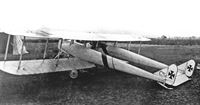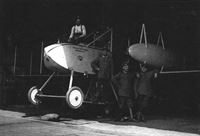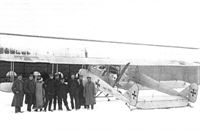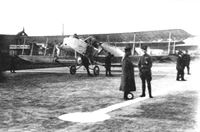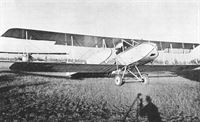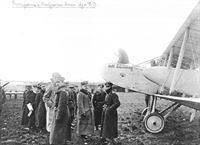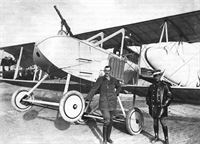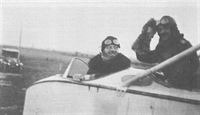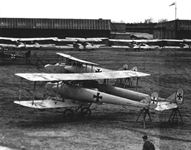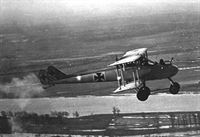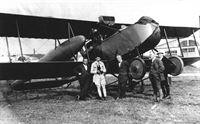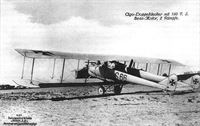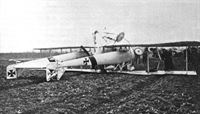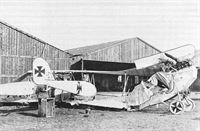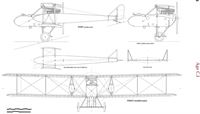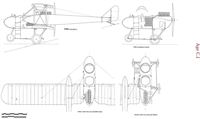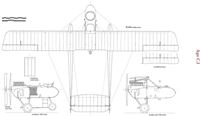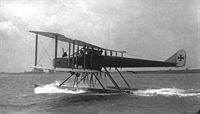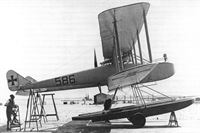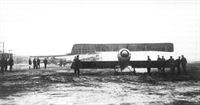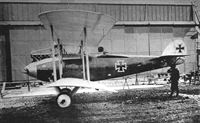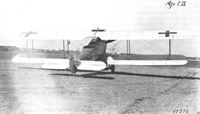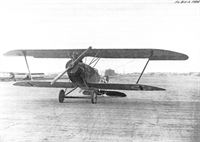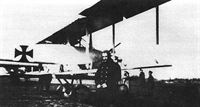Книги
Centennial Perspective
J.Herris
Otto, AGO and BFW Aircraft of WWI
420
J.Herris - Otto, AGO and BFW Aircraft of WWI /Centennial Perspective/ (37)
Ago C.I aircraft in the left background serve with a battleplane, an AEG G.II. (Peter M. Grosz Collection/STDB)
Ago Pusher Seaplane Trainer
The Ago Seaplane Pusher Trainer was a 1912 amphibian development of the Ago Pusher Trainer and like it was a two-seater. The main floats were added under the fuselage nacelle and another, smaller pair of floats were added under the tail to keep the tail out of the water. Wheels were attached to the main floats that could be folded up out of the way for water operation.
The additional weight of the floats required more power and a larger wing, especially for the greater friction of water take-offs. An 150 hp Argus was fitted for the extra power needed and the wings were extended from three or three and a half bays of the land version to four and a half bays. Wing span was 18 meters.
The Ago Seaplane Pusher Trainer was a 1912 amphibian development of the Ago Pusher Trainer and like it was a two-seater. The main floats were added under the fuselage nacelle and another, smaller pair of floats were added under the tail to keep the tail out of the water. Wheels were attached to the main floats that could be folded up out of the way for water operation.
The additional weight of the floats required more power and a larger wing, especially for the greater friction of water take-offs. An 150 hp Argus was fitted for the extra power needed and the wings were extended from three or three and a half bays of the land version to four and a half bays. Wing span was 18 meters.
This Ago Seaplane Pusher Trainer carried competition number D7. The photo illustrates its amphibian design and here is on its wheels.
The Ago Seaplane Pusher Trainer was a seaplane derived from the Ago Pusher trainer. Floats were added under the fuselage nacelle and under the tailplane and the wings are extended to 4 1/2 bays of bracing. The additional wing area was needed due to the additional weight, especially during a water take-off. (Peter M. Grosz Collection/STDB)
Ago Floatplane Pusher Trainer Marine Number D15 photographed February 2, 1914 while being refueled by hand.The wheels have been removed. (Peter M. Grosz Collection/STDB)
Seaplanes were allocated consecutive numbers which at first were prefixed with 'D' for Doppeldecker (biplane) or 'E' for Eindecker (monoplane); however, after number 20 had been issued, the use of the prefix was discontinued. Shown here is Ago pusher seaplane D15 at Kolberg on 12 February 1914; built in 1913, this machine was powered by an 80hp Argus engine. The marine number marked on the nacelle is also carried on the outer surfaces of the outboard rudders. Following mobilization, 'Kiel' was additionally marked on the outboard sides of the floats.
Seaplanes were allocated consecutive numbers which at first were prefixed with 'D' for Doppeldecker (biplane) or 'E' for Eindecker (monoplane); however, after number 20 had been issued, the use of the prefix was discontinued. Shown here is Ago pusher seaplane D15 at Kolberg on 12 February 1914; built in 1913, this machine was powered by an 80hp Argus engine. The marine number marked on the nacelle is also carried on the outer surfaces of the outboard rudders. Following mobilization, 'Kiel' was additionally marked on the outboard sides of the floats.
An Ago Floatplane Pusher Trainer taxiing on the water.The wheels have been removed. (Peter M. Grosz Collection/STDB)
The Ago Arrow biplane (Ago no. 22) was built in 1913 and powered by a 120 hp Argus As.II.The two and a half bay wing spanned 13.90 m and finned side radiators were fitted.The cockpits were widely separated. (Peter M. Grosz Collection/STDB)
The rear of the AGO Flugzeugwerke at Johannisthal that bordered on the airfield with various Ago aircraft.
AGO E.I
In 1913 the AGO company produced a single prototype of a so-called Kalvalleris monoplane, or cavalry airplane. It was a pre-war concept; that is, it was a small, unarmed two-seater intended for fast, visual reconnaissance. Company designation E.I was given; no military serial was assigned and it was not formally an E-type.
The E.I was powered by a 120 hp Daimler D.I engine. The aircraft had a primitive brow radiator and a modest top speed of 135 km/h despite the fairly powerful engine. The aircraft was given Ago number 20 on the rudder but no fixed fin was fitted. No production ensured.
In 1913 the AGO company produced a single prototype of a so-called Kalvalleris monoplane, or cavalry airplane. It was a pre-war concept; that is, it was a small, unarmed two-seater intended for fast, visual reconnaissance. Company designation E.I was given; no military serial was assigned and it was not formally an E-type.
The E.I was powered by a 120 hp Daimler D.I engine. The aircraft had a primitive brow radiator and a modest top speed of 135 km/h despite the fairly powerful engine. The aircraft was given Ago number 20 on the rudder but no fixed fin was fitted. No production ensured.
The Ago E.I (company designation) monoplane prototype of 1913. This two-seater was a reconnaissance prototype.
The rear of the AGO Flugzeugwerke at Johannisthal that bordered on the airfield with various Ago aircraft.
Ago Tractor Biplane Trainer
In 1913 Ago produced the Tractor Biplane Trainer. It was a conventional design powered by a 100 hp Gnome rotary engine. The wings had three bays of bracing.
Ago Tractor Biplane Floatplane Trainer
In 1913 Ago produced the Tractor Biplane Trainer. The Tractor Floatplane Trainer was a floatplane development of that aircraft and like it was a conventional three-bay biplane design powered by a 100 hp Gnome rotary engine. A few purchased by the Navy were assigned Marine Numbers 30-39.
In 1913 Ago produced the Tractor Biplane Trainer. It was a conventional design powered by a 100 hp Gnome rotary engine. The wings had three bays of bracing.
Ago Tractor Biplane Floatplane Trainer
In 1913 Ago produced the Tractor Biplane Trainer. The Tractor Floatplane Trainer was a floatplane development of that aircraft and like it was a conventional three-bay biplane design powered by a 100 hp Gnome rotary engine. A few purchased by the Navy were assigned Marine Numbers 30-39.
Ago Tractor Biplane Floatplane Marine Number 32 assigned to the seaplane station at Kiel for training. (Peter M. Grosz Collection/STDB)
Ago Tractor Biplane Floatplane Marine Number 31 assigned to the seaplane station at Kiel for training. (Peter M. Grosz Collection/STDB)
Sanke card 323 showing the interior of the AGO Flugzeugwerke at Johannisthal. Various early Ago aircraft are being built.
Ago Biplane Seaplane
The Ago Seaplane Biplane was a totally new pusher design. The aircraft was powered by a 150 hp Argus As .III. Two floats were fitted and no tail float was needed. A few were purchased by the Navy and assigned Marine Numbers 65-69 (powered by the Argus As.III).
The Ago Seaplane Biplane was a totally new pusher design. The aircraft was powered by a 150 hp Argus As .III. Two floats were fitted and no tail float was needed. A few were purchased by the Navy and assigned Marine Numbers 65-69 (powered by the Argus As.III).
The Ago Seaplane Biplane (number 9) with another in the background. (Peter M. Grosz Collection/STDB)
Ago School Biplane
The Ago Military Biplane Pusher was a conventional two-bay biplane pusher design powered by a 150 hp Argus engine. There was no fixed fin, a single rudder, and the horizontal tailplane was monoplane.
The tail support design was a high-drag lattice similar to many Allied designs. This design preceded the C.I which had tail booms and two fins and rudders that reduced drag and improved strength and stability.
The Ago Military Biplane Pusher was a conventional two-bay biplane pusher design powered by a 150 hp Argus engine. There was no fixed fin, a single rudder, and the horizontal tailplane was monoplane.
The tail support design was a high-drag lattice similar to many Allied designs. This design preceded the C.I which had tail booms and two fins and rudders that reduced drag and improved strength and stability.
An Ago C.I military biplane pusher prototype was powered by a 150 hp Argus.The vertical tail had no fixed fin and a single rudder; the horizontal tail was a monoplane. Ago DV 3 Naval number S.57 is in the background. (Peter M. Grosz Collection/STDB)
Ago C.I
The AGO copies of the Otto pusher design had limited performance and failed to excite the interest of the Prussian Fliegertruppe who regarded these primitive aircraft as outmoded and were not impressed by the design or workmanship. In fact, the Fliegertruppe expressly prohibited the demonstration of new AGO aircraft because they considered it a waste of effort. In addition to all these negatives, the Prussian authorities strongly preferred the tractor aircraft configuration to the pusher configuration.
AGO therefore had strong headwinds to overcome to sell aircraft to the military and had to focus on selling aircraft to the Navy. AGO had built some early seaplanes for the Navy that were overweight, fragile, and not successful. Now the Navy excluded AGO from further consideration, although the Navy did buy the few AGO landplanes available when war broke out and they were desperate for trainers.
Introduction of the C.I in early 1915 briefly transformed Ago's fortunes. The C.I was a pusher design that was much improved compared to the Ago-Otto pusher trainer design. The engine was a 150 hp Benz Bz.III that was more reliable than the engines fitted to the pusher trainer design and more powerful than most of them. Later production C.I aircraft also used the 160 hp Mercedes D.III and a few used the 160 hp Maybach Mb.III depending on engine availability.
The C.I had a robust airframe with sturdy four-wheel undercarriage. Later the front wheels of the undercarriage were often eliminated for improved speed and climb performance.
The tail was carried by two streamlined booms that were constructed of wood strips wrapped around a wood frame. Compared to the typical 'lattice tail' pusher designs the Ago C.I was stronger and more streamlined. Movable rudders without fixed fins were fitted to the prototype, but production aircraft had fixed fins for improved stability.
Two crew were carried in the central nacelle with the engine behind them. The observer occupied the front cockpit for the best field of view for reconnaissance and the best field of fire for the single flexible machine gun fitted for his use.
The prototype and early production aircraft had side radiators for cooling. Later, airfoil radiators were fitted to reduce drag and vulnerability to enemy fire when they became available.
The C.I had the typical pusher drawbacks and for that reason few were purchased by the Fliegertruppe. However, it was used by the Bavarian air service, which liked pushers, and the Navy, always short of aircraft, bought some as well. In addition the Navy bought one floatplane version of the C.I, the C.Iw. A few were used by the Fliegertruppe.
The Otto C.I pusher was briefly used, but the comparatively refined Ago C.I was the only German single-engine pusher used in quantity in combat over the Western Front. It was never numerous but was noticed by the Allies because it was a pusher, an configuration unique to the Ago (and preceding Otto) C.I. It is known to have served with Bavarian Feld-Flieger Abteilung 5b, 8b, 9b, and other units of the Bavarian air service.
Ago C.II
The Ago C.II was a slightly refined, somewhat more powerful development of the Ago C.I with enlarged wing. The 150 hp Benz Bz.III was replaced by a 160 hp Mercedes D.III and the 2-bay wing of the C.I was replaced by a 3-bay wing. An airfoil radiator was fitted as used by later-production Ago C.I aircraft and the airframe was slightly refined.
The modest power increase and airframe refinement provided a small speed increase.
The future did not belong to pusher aircraft and few examples of the C.II were built and used. According to the Frontbestand a maximum of two were at the front at the end of 1915 and a few were used by the Navy.
Ago C.I Aircraft Production
Order Serials Qty Notes
Feb. 1915 C.1-8/15 8 Side radiators
Feb. 22, 1915 S 158-162 5 For the Navy
Apr. 1915 C.94-105/15 12 Airfoil radiator
1915 C.191-192/15 2 Airfoil radiator
May 1915 C.349-373/15 25 Airfoil radiator
Oct. 1915 C.1903-1914/15 12 Airfoil radiator, two-wheel undercarriage.
Ago C-Type Specifications
Ago C.I Ago C.Iw Ago C.II Ago C.IIw
Engine 150 hp Benz Bz.III 150 hp Benz Bz.III 160 hp Mercedes D.III 220 hp Benz Bz.EV
160 hp Mercedes D.III
160 hp Maybach Mb.III
Span, Upper 15.1 m 15.1 14.50 m (or 18.30 m) 18.3 m
Span, Lower 14.34 m 14.34 m - -
Chord, Upper 1.70 m 1.70 m - -
Chord, Lower 1.70 m 1.70 m - -
Gap 1.74 m 1.74 m - -
Wing Area 47.6 m2 47.6 m2 - -
Length 9.30 m 9.30 m 9.84 m 11.24 m
Height 3.10 m - - -
Empty Weight 960 kg 845 kg 1360 kg -
Loaded Weight 1,495 kg 1,405 kg 1,946 kg -
Maximum Speed 130 km/h 130 km/h 137 km/h -
Climb to 1,000 m 9.5 min. - - -
Climb to 2,000 m 24 min. - - -
Climb to 3,000 m 45 min. - - -
The AGO copies of the Otto pusher design had limited performance and failed to excite the interest of the Prussian Fliegertruppe who regarded these primitive aircraft as outmoded and were not impressed by the design or workmanship. In fact, the Fliegertruppe expressly prohibited the demonstration of new AGO aircraft because they considered it a waste of effort. In addition to all these negatives, the Prussian authorities strongly preferred the tractor aircraft configuration to the pusher configuration.
AGO therefore had strong headwinds to overcome to sell aircraft to the military and had to focus on selling aircraft to the Navy. AGO had built some early seaplanes for the Navy that were overweight, fragile, and not successful. Now the Navy excluded AGO from further consideration, although the Navy did buy the few AGO landplanes available when war broke out and they were desperate for trainers.
Introduction of the C.I in early 1915 briefly transformed Ago's fortunes. The C.I was a pusher design that was much improved compared to the Ago-Otto pusher trainer design. The engine was a 150 hp Benz Bz.III that was more reliable than the engines fitted to the pusher trainer design and more powerful than most of them. Later production C.I aircraft also used the 160 hp Mercedes D.III and a few used the 160 hp Maybach Mb.III depending on engine availability.
The C.I had a robust airframe with sturdy four-wheel undercarriage. Later the front wheels of the undercarriage were often eliminated for improved speed and climb performance.
The tail was carried by two streamlined booms that were constructed of wood strips wrapped around a wood frame. Compared to the typical 'lattice tail' pusher designs the Ago C.I was stronger and more streamlined. Movable rudders without fixed fins were fitted to the prototype, but production aircraft had fixed fins for improved stability.
Two crew were carried in the central nacelle with the engine behind them. The observer occupied the front cockpit for the best field of view for reconnaissance and the best field of fire for the single flexible machine gun fitted for his use.
The prototype and early production aircraft had side radiators for cooling. Later, airfoil radiators were fitted to reduce drag and vulnerability to enemy fire when they became available.
The C.I had the typical pusher drawbacks and for that reason few were purchased by the Fliegertruppe. However, it was used by the Bavarian air service, which liked pushers, and the Navy, always short of aircraft, bought some as well. In addition the Navy bought one floatplane version of the C.I, the C.Iw. A few were used by the Fliegertruppe.
The Otto C.I pusher was briefly used, but the comparatively refined Ago C.I was the only German single-engine pusher used in quantity in combat over the Western Front. It was never numerous but was noticed by the Allies because it was a pusher, an configuration unique to the Ago (and preceding Otto) C.I. It is known to have served with Bavarian Feld-Flieger Abteilung 5b, 8b, 9b, and other units of the Bavarian air service.
Ago C.II
The Ago C.II was a slightly refined, somewhat more powerful development of the Ago C.I with enlarged wing. The 150 hp Benz Bz.III was replaced by a 160 hp Mercedes D.III and the 2-bay wing of the C.I was replaced by a 3-bay wing. An airfoil radiator was fitted as used by later-production Ago C.I aircraft and the airframe was slightly refined.
The modest power increase and airframe refinement provided a small speed increase.
The future did not belong to pusher aircraft and few examples of the C.II were built and used. According to the Frontbestand a maximum of two were at the front at the end of 1915 and a few were used by the Navy.
Ago C.I Aircraft Production
Order Serials Qty Notes
Feb. 1915 C.1-8/15 8 Side radiators
Feb. 22, 1915 S 158-162 5 For the Navy
Apr. 1915 C.94-105/15 12 Airfoil radiator
1915 C.191-192/15 2 Airfoil radiator
May 1915 C.349-373/15 25 Airfoil radiator
Oct. 1915 C.1903-1914/15 12 Airfoil radiator, two-wheel undercarriage.
Ago C-Type Specifications
Ago C.I Ago C.Iw Ago C.II Ago C.IIw
Engine 150 hp Benz Bz.III 150 hp Benz Bz.III 160 hp Mercedes D.III 220 hp Benz Bz.EV
160 hp Mercedes D.III
160 hp Maybach Mb.III
Span, Upper 15.1 m 15.1 14.50 m (or 18.30 m) 18.3 m
Span, Lower 14.34 m 14.34 m - -
Chord, Upper 1.70 m 1.70 m - -
Chord, Lower 1.70 m 1.70 m - -
Gap 1.74 m 1.74 m - -
Wing Area 47.6 m2 47.6 m2 - -
Length 9.30 m 9.30 m 9.84 m 11.24 m
Height 3.10 m - - -
Empty Weight 960 kg 845 kg 1360 kg -
Loaded Weight 1,495 kg 1,405 kg 1,946 kg -
Maximum Speed 130 km/h 130 km/h 137 km/h -
Climb to 1,000 m 9.5 min. - - -
Climb to 2,000 m 24 min. - - -
Climb to 3,000 m 45 min. - - -
Ago C.I prototype with final tail surfaces and assigned serial 1/15. Flown by Lt. Max Ihn and Oblt. Max Freiherr von und zu Fraunberg of F.FI.Abt. 6, April 1915.
Ago C.I 96/15 of Feld-Flieger Abteilung 9b. The pilot was Lt. Auer and the observer was Oblt. Paulin. Their names were painted on the rudder. The nose has been modified to carry a long-focal length camera.
Ago C.I 97/15 of Feld-Flieger Abteilung 9b. The pilot was Vzfw. Bruno Chorbacher and the observer was Lt.d.R. Ludwig Schmidt. They were based at Flugplatz Colmar.
The Ago C.I prototype photographed at Johannisthal when rolled out in January/February 1915. The tail had no fixed fins; these were added to production aircraft.The prototypes and first production series had side radiators. Power for the prototype was a 150hp Benz Bz.III. (Peter M. Grosz Collection/STDB)
The Ago C.I prototype at Johannisthal in January/February 1915.The light yellow varnished tail booms appear dark due to the film used. (Peter M. Grosz Collection/STDB)
The Ago C.I prototype was modified with the additional of vertical fins and new rudders, then given military serial C.1/15. This was first serial ever applied to an armed, two-seat biplane. According to Idflieg, this was also the first German aircraft armed with a Parabellum LMG 14 machine gun. In April 1915 the aircraft was assigned to Feld-Flieger Abteilung 6.There it was flown by Lt. Max Ihn (pilot) and Oblt. Max Freiherr von und zu Fraunberg as observer.
Ago C.I C.1/15 after the tailplane was modified with fixed fins; it was then assigned to Feld-Flieger Abteilung 9b.
Ago C.I C.96/15 of Feld-Flieger Abteilung 9b on the airfield. The front wheels have been removed from the undercarriage.
Ago C.l 96/15; the black and white stripes are the unit marking of Armee-Abteilung Gaede. It was part of the third production batch that was powered by the 160 hp Mercedes D.III. (Peter M. Grosz Collection/STDB)
Ago C.I 96/15 of Feld-Flieger Abteilung 9b undergoing minor maintenance. (Bruno Schmaling)
This view of Ago C.I 96/15 of Armee-Abteilung Gaede shows the Armee marking on both sides of the tail booms. (Peter M. Grosz Collection/STDB)
This view of Ago C.I 96/15 of Armee-Abteilung Gaede shows the Armee marking on both sides of the tail booms. (Peter M. Grosz Collection/STDB)
Ago C.I 96/15 of Feld-Flieger Abteilung 9b with assigned crew Lt. Hans Auer (pilot) and Oblt. Karl Paulin (observer).The small print on the rudder reads "Fuhrer Lt. Auer and Beob. Oblt. Paulin." The roundel dated 4-1-16 patched a French bullet hole. (Bruno Schmaling)
Ago C.I 96/15 of Feld-Flieger Abteilung 9b with assigned crew Lt. Hans Auer (pilot) and Oblt. Karl Paulin (observer).The small print on the rudder reads "Fuhrer Lt. Auer and Beob. Oblt. Paulin." The roundel dated 4-1-16 patched a French bullet hole. (Bruno Schmaling)
Ago C.I 96/15 was powered by a 160 hp Mercedes D.III. The black and white markings were those of Armee-Abteilung Gaede for the purpose of air-to-air identification to avoid attack by other German aircraft. These markings were seen as vertical black/white bands on other aircraft types. (Peter M. Grosz Collection/STDB)
Observer Oblt. Karl Paulin and pilot Lt. Hans Auer pose in their assigned aircraft, Ago C.I 96/15.The black and white stripes are the unit marking of Bavarian Feld-Flieger Abteilung 9b. It was part of the third production batch that was powered by the 160 hp Mercedes D.III. (Peter M. Grosz Collection/STDB)
Ago C.I C.96/15 of Feld-Flieger Abteilung 9b before the front wheels were removed from the undercarriage.
Ago C.I 96/15 of Bavarian Feld-Flieger Abteilung 9b. Carl Hailer (at right) called this photo the Ski Abteilung 9b. (Peter M. Grosz Collection/STDB)
Ago C.I 98/15 ready for take-off in the winter Vosges hills. It has the markings of Armee-Abteilung Gaede and is probably from Bavarian FFA 9b. (Peter M. Grosz Collection/STDB)
Ago C.I powered by a 160 hp Mercedes D.III. Despite the greater power, performance was improved only modestly.
Ago C.I transferred to the Navy at Nieuwmenster in Belgium in 1915. The original Army serial has been replaced by LF 181 (LF = Landflugzeug). (Peter M. Grosz Collection/STDB)
Ago C.I LF 181 was assigned to the Navy. The red identification pennants used on German seaplanes is attached to the lower wing tips.
Ago C.I and crewmen of Armee-Abteilung Gaede. The aircrew liked the docile, reliable Ago C.I and flew it for months until the air combat environment became too hostile. (Peter M. Grosz Collection/STDB)
The crew poses in the snow with their Ago C.I. The observer had an unrestricted field of fire forward but, like all pushers, was vulnerable to attack from behind and below. Despite the streamlined tail booms the design was comparatively high drag compared to its tractor contemporaries and was thus relatively slow. (Peter M. Grosz Collection/STDB)
Early Ago C.I with side radiators of Feldflieger-Abteilung 23 was crewed by Ltn. Walter Sieber (pilot) and Ltn. Spatz (observer).The photo was taken at Roupy. (Peter M. Grosz Collection/STDB)
Rudolf Berthold (right) poses with Ernst Schlegel in front of an AGO C.I at Armee-Flug-Park (formerly Etappen Flugzeug-Park) 2's airfield near Bellenglise.
An Ago C.I of Feld-Flieger Abteilung 8b.The officer is Hptm. Schmoger. Attached to the nose is a test setup involving a radiator. Is this an evaluation of the radiator from a new vendor or new design? (Bruno Schmaling)
An Ago C.I of Feld-Flieger Abteilung 8b.The radiator test setup is attached to the nose. (Bruno Schmaling)
Oblt. Rudolf Berthold sits in the aft cockpit of an Ago C.I with Oblt. Fritz Bohmer as his observer. Mounted on the nose of the plane just in front of Bohmer's windscreen is what appears to have been a goose figure as a good luck charm
Early Ago C.I of Feld-Flieger Abteilung 23 with side radiators. The crew was Lt. Walter Sieber (pilot) and Lt. Spatz (observer), and the photo was taken at Roupy. Note the observer's wind screen, which was mounted on the gun ring, has been turned out of the way as the observer bringing the gun into firing position. (Bruno Schmaling)
From its unit markings this Ago C.I appears to be from Feld-Flieger Abteilung 9b but FFA 5b is also possible. Use of a tent hangar indicates the unit is at the front. (Bruno Schmaling)
Ago C.I C.1/15 with Lt. Max Ihn (pilot) and Oblt. Max Freiherr von und zu Fraunberg as observer flying with FFA 6.
An Ago C.I of Feld-Flieger Abteilung 8b flown by pilot Uffz. Wilhelm and observer Oblt. Rudolf Schonger. (Bruno Schmaling)
Ago C.I aircraft from Feld-Flieger Abteilung 9b before application of unit markings. (Bruno Schmaling)
Ago C.I aircraft in the left background serve with a battleplane, an AEG G.II. (Peter M. Grosz Collection/STDB)
An Ago C.I is in the right background with a Fokker D.II in the foreground. (Peter M. Grosz Collection/STDB)
Detailed rear view of an Ago C.I powered by a 160 hp Mercedes D.III. (Peter M. Grosz Collection/STDB)
The take-off of an Ago C.I of Feld-Flieger Abteilung 8b. The aircraft has a two-wheel undercarriage. (Bruno Schmaling)
Unknown Ago C.I in flight; may be an enlargement of the facing photo of C.I of Feld-Flieger Abteilung 9b taking off from Colmar.
Ago C.I in flight. Pushers offered unrestricted fields of view forward but were vulnerable in air to air combat. (Peter M. Grosz Collection/STDB)
An Ago C.I photographed in flight shows the structure through the translucent fabric. The insignia are painted over square white backgrounds. (Peter M. Grosz Collection/ STDB)
Ago C.I aircraft of FFA 9b modified to carry a long focal length camera. Lt Hans Kuchler was the observer and Vzfw. Dorner was the pilot. (Peter M. Grosz Collection/STDB)
Carl Hailer installing a 120 cm focal length camera in a modified Ago C.I. (Peter M. Grosz Collection/ STDB)
On 10 July 1919, Ago C.I (D-118) arrived in Holland. The letters LB 2 (Lich T Bild 2) and a five-pointed star are under the left wing. The leading edge radiator was from a Rumpler. (Peter M. Grosz Collection/STDB)
On 10 July 1919, Ago C.I (D-118) arrived in Holland. The letters LB 2 (Lich T Bild 2) and a five-pointed star are under the left wing. The leading edge radiator was from a Rumpler. (Peter M. Grosz Collection/STDB)
Ago C.I LB2 postwar modified with a Rumpler leading edge radiator replacing the standard airfoil radiator. It was photographed in Holland. (Peter M. Grosz Collection/STDB)
Postwar view of a modifed Ago C.I with non-standard leading edge radiator photographed in Holland showing the markings LB 2 on the tail boom. Civil registration D-118 was added to the fin later. Suppressed national markings on the upper wing suggests this C.I was the one intended for firing trails of the 2 cm Becker cannon in late 1918. (Peter M. Grosz Collection/STDB)
S.66 was an Ago C.II assigned to the Navy. The text on the nose appears to read "Schneewittchen" or 'Snow White.' This name was applied to a number of early German two-seaters that were finished in a pale color. (Peter M. Grosz Collection/STDB)
Overhead view of the Ago C.II. The three-bay, long-span wings are clearly shown. (Peter M. Grosz Collection/STDB)
Ago C.I 371/15 of Bavarian Feld-Flieger Abteilung 9b was hit by anti-aircraft fire during a mission in September 1916 with this result. The crew was pilot Unteroffizier Ludwin Hilz and observer Leutnant Alois Simson. This close-up shows the bracing strut and the fact the fin was suspended above the tail boom.The tail cross was painted on both sides of the rudder. (Peter M. Grosz Collection/STDB)
Ago C.I C.1/15 after a collision with an automobile. Additional cross-bracing has been added to the center section.
Crash of an Ago C.I; the four-wheel undercarriage was safer than the usual two-wheel undercarriage but rough terrain could still cause landing accidents.
Ago C.I 7/15 after landing on a plowed field. It was from Bavarian FFA 9b and has the markings of Armee-Abteilung Gaede. (Peter M. Grosz Collection/STDB)
The crash of Ago C.I 349/15 of Feld-Flieger Abteilung 9b. The engine quit on take-off and the result was disaster. In such an event the engine would plow into the crew's back. Carl Hailer was pilot of this aircraft and, an excellent athlete, saved his life by jumping free of his cockpit just before impact. (Bruno Schmaling)
The crash of Ago C.I 370/15 of Feld-Flieger Abteilung 9b on Oct. 25,1916. The crew was Lt. Biederrmann and Vzfw. Ertl. (Bruno Schmaling)
This document from Feld-Flieger Abteilung 9b shows the unit markings of the Ago C.I starting in 1915. Feld-Flieger Abteilung 9b was part of Armee-Abteilung Gaede and the black and white bands were specified by Armee-Abteilung Gaede for the purpose of air-to-air identification to avoid attack by other German aircraft. The Otto C.I and Ago C.I resembled French pushers from a distance in the air and the black/white bands were intended to enable German aircraft to identify other German aircraft in the air. The Pfalz and Fokker Eindeckers resembled Morane-Saulnier Bullets in the air. Diagonal black/white bands were also used on other aircraft types such as Aviatik B- and C-types, AEG C-types, Pfalz Parasols, Fokker Eindeckers, and AEG G.IIs. These markings were also seen as vertical black/white bands on other aircraft types such as Aviatik B- and C-types, Pfalz Eindeckers, Fokker Eindeckers, and AEG G.IIs. So the use of diagonal black/white bands around the fuselage indicates the aircraft was attached to Armee-Abteilung Gaede, not specifically to Feld-Flieger Abteilung 9b. (Greg VanWyngarden)
Ago C.Iw
The Ago C.Iw used a standard C.I airframe with a robust float undercarriage instead of wheels.
One airframe, Marine Number 115, was built. Power was from a 150 hp Benz Bz.III, the same engine that powered many standard C.I aircraft, that used the early production side radiators.
The aircraft was naval category CB, which means an armed two-seater (it had a flexible machine gun in the observer's cockpit) with bombing equipment.
After evaluation at the SVK test center the C.Iw was assigned to Zeebrugge for operational evaluation and arrived there in July 1915.
Ago C.IIw
The Ago C.IIw was a floatplane adaptation of the three-bay Ago C.II. Engine power was a 200 hp Benz Bz.IV. Only two aircraft, Marine Numbers 539 and 586, were built.
Ago C-Type Specifications
Ago C.I Ago C.Iw Ago C.II Ago C.IIw
Engine 150 hp Benz Bz.III 150 hp Benz Bz.III 160 hp Mercedes D.III 220 hp Benz Bz.EV
160 hp Mercedes D.III
160 hp Maybach Mb.III
Span, Upper 15.1 m 15.1 14.50 m (or 18.30 m) 18.3 m
Span, Lower 14.34 m 14.34 m - -
Chord, Upper 1.70 m 1.70 m - -
Chord, Lower 1.70 m 1.70 m - -
Gap 1.74 m 1.74 m - -
Wing Area 47.6 m2 47.6 m2 - -
Length 9.30 m 9.30 m 9.84 m 11.24 m
Height 3.10 m - - -
Empty Weight 960 kg 845 kg 1360 kg -
Loaded Weight 1,495 kg 1,405 kg 1,946 kg -
Maximum Speed 130 km/h 130 km/h 137 km/h -
Climb to 1,000 m 9.5 min. - - -
Climb to 2,000 m 24 min. - - -
Climb to 3,000 m 45 min. - - -
The Ago C.Iw used a standard C.I airframe with a robust float undercarriage instead of wheels.
One airframe, Marine Number 115, was built. Power was from a 150 hp Benz Bz.III, the same engine that powered many standard C.I aircraft, that used the early production side radiators.
The aircraft was naval category CB, which means an armed two-seater (it had a flexible machine gun in the observer's cockpit) with bombing equipment.
After evaluation at the SVK test center the C.Iw was assigned to Zeebrugge for operational evaluation and arrived there in July 1915.
Ago C.IIw
The Ago C.IIw was a floatplane adaptation of the three-bay Ago C.II. Engine power was a 200 hp Benz Bz.IV. Only two aircraft, Marine Numbers 539 and 586, were built.
Ago C-Type Specifications
Ago C.I Ago C.Iw Ago C.II Ago C.IIw
Engine 150 hp Benz Bz.III 150 hp Benz Bz.III 160 hp Mercedes D.III 220 hp Benz Bz.EV
160 hp Mercedes D.III
160 hp Maybach Mb.III
Span, Upper 15.1 m 15.1 14.50 m (or 18.30 m) 18.3 m
Span, Lower 14.34 m 14.34 m - -
Chord, Upper 1.70 m 1.70 m - -
Chord, Lower 1.70 m 1.70 m - -
Gap 1.74 m 1.74 m - -
Wing Area 47.6 m2 47.6 m2 - -
Length 9.30 m 9.30 m 9.84 m 11.24 m
Height 3.10 m - - -
Empty Weight 960 kg 845 kg 1360 kg -
Loaded Weight 1,495 kg 1,405 kg 1,946 kg -
Maximum Speed 130 km/h 130 km/h 137 km/h -
Climb to 1,000 m 9.5 min. - - -
Climb to 2,000 m 24 min. - - -
Climb to 3,000 m 45 min. - - -
Ago C.Iw (MN 115) was a C.I with floats instead of wheels attached via a robust assembly of struts. One aircraft, MN 115, was built and eventually assigned to Zeebrugge. Power was a 150 hp Benz Bz.III.
Ago C.Iw (MN 115) on a railway flatcar in front of Hangar 3 on the mole at Zeebrugge. The tail booms are made of a light birchwood veneer and only appear dark in the photo due to the film used. (M. Szigeti)
The Ago C.IIw was developed from the Ago C.II. The additional wing area was needed to provide the lift needed to take-off from the water due to the extra weight of the floats and the greater friction of the water. (Peter M. Grosz Collection/STDB)
Ago C.IIw MN 539 was the first of two aircraft built. Several men in the original photograph have been crudely erased. (Peter M. Grosz Collection/STDB)
Ago Biplane Trainer (DV 3)
The Ago Biplane Trainer was a conventional two-bay biplane design built in 1915 and powered by a 100 hp Oberursel U.I rotary engine. There was no fixed fin and no armament.
The Ago Biplane Trainer was a conventional two-bay biplane design built in 1915 and powered by a 100 hp Oberursel U.I rotary engine. There was no fixed fin and no armament.
The Ago DV 3 was powered by a 100 hp Oberursel U.I rotary.The tail had no fixed fin. (Peter M. Grosz Collection/ STDB)
The improved Ago DV 3 was still powered by a 100 hp Oberursel U.I rotary but had a more streamlined, full cowling and propeller spinner.The tail had no fixed fin. (Peter M. Grosz Collection/STDB)
An Ago C.I military biplane pusher prototype was powered by a 150 hp Argus.The vertical tail had no fixed fin and a single rudder; the horizontal tail was a monoplane. Ago DV 3 Naval number S.57 is in the background. (Peter M. Grosz Collection/STDB)
Ago C.III
Ago's last pusher design was the C.III. It was a small, single-bay biplane powered by a 160 hp Mercedes D.III engine.
The more compact aircraft did not offer enough performance improvement over the C.I and C.II, and only one prototype of the Ago C.III was built; there were no production aircraft. Unfortunately, little information on the type is available. However, the Frontbestand chart for C-types indicated the Ago C.III was at the front in the February 1916 inventory, so the prototype was apparently evaluated at the front.
By early 1916 the time of the pusher configuration was over and all additional Ago designs were tractor configuration.
Ago C-Type Specifications
Ago C.III Ago C.IV
Engine 160 hp Mercedes D.III 200 hp Benz Bz.IV
Span, Upper 11.0m 11.90 m
Wing Area - 37.5 m2
Length 7.0 m 8.25 m
Height - 3.50 m
Empty Weight - 900 kg
Loaded Weight - 1,350 kg
Maximum Speed - 190 km/h
Climb to 3,000 m - 22 min.
Ceiling - 5,500 m.
Ago's last pusher design was the C.III. It was a small, single-bay biplane powered by a 160 hp Mercedes D.III engine.
The more compact aircraft did not offer enough performance improvement over the C.I and C.II, and only one prototype of the Ago C.III was built; there were no production aircraft. Unfortunately, little information on the type is available. However, the Frontbestand chart for C-types indicated the Ago C.III was at the front in the February 1916 inventory, so the prototype was apparently evaluated at the front.
By early 1916 the time of the pusher configuration was over and all additional Ago designs were tractor configuration.
Ago C-Type Specifications
Ago C.III Ago C.IV
Engine 160 hp Mercedes D.III 200 hp Benz Bz.IV
Span, Upper 11.0m 11.90 m
Wing Area - 37.5 m2
Length 7.0 m 8.25 m
Height - 3.50 m
Empty Weight - 900 kg
Loaded Weight - 1,350 kg
Maximum Speed - 190 km/h
Climb to 3,000 m - 22 min.
Ceiling - 5,500 m.
The Ago C.III was a single-bay biplane powered by a 160 hp Mercedes D.III. (Peter M. Grosz Collection/STDB)
The Ago C.III was a single-bay biplane powered by a 160 bp Mercedes D.III. (Peter M. Grosz Collection/STDB)
Ago C.IV
Ago had exhausted the potential of the pusher configuration with its C.I, C.II, and C.III designs. To achieve better performance and to create a design that could be sold to the Prussian-dominated Fliegertruppe, Ago turned to the tractor configuration.
The result was the Ago C.IV, an innovative design of conventional construction that offered much better speed and climb than the pushers that preceded it.
The Ago C.IV was most easily distinguished from other two-seaters in having a sharply-tapered wing planform. Most WWI aircraft had untapered wings of rectangular planform for ease of manufacturer. However, the induced drag (drag induced by lift) depends on the wing planform, and theoretical calculations indicate that an elliptical wing planform minimizes induced drag. (See the Spitfire for an example of an actual design using this principle.) An elliptical planform wing is difficult to manufacture. However, it can be approximated by the tapered wing planform, which is a compromise.
The tapered wing has less drag than a rectangular wing but is harder to build. It has more drag than an elliptical wing but is easier to build.
The resulting C.IV with 220 hp Benz Bz.IV engine was faster than most two-seat reconnaissance airplanes. It was carefully designed to have clean lines and be relatively streamlined for the time. The combination of good power, uncluttered lines, and tapered wing planform gave it good speed and climb for its time. It was much faster than the C.I that Ago had been building, and had the tractor configuration preferred by the Fliegertruppe. Ago appeared to have found the formula, and the C.IV was ordered in quantity starting in June 1916.
Actual design of the Ago C.IV had started in late 1915. Another innovative feature of the C.IV was the lack of a forward, inboard bracing strut to provide a better field of fire forward between the wings for the observer. Ago was given Patent No. 299,149 for this innovation on Oct. 7, 1915, as they were designing the C.IV.
The Ago C.IV prototype flew in early 1916 and immediately demonstrated good performance. In trials flown on May 21 the prototype reached 4,000 m altitude in 32 minutes, fast for the time. This encouraged Idflieg to order 24 aircraft in June 1916. Contemporary Idflieg files referred to the Ago C.IV as the so-called light C-type. It was thus a precursor of the later CL-class.
Type-testing was completed in mid-June. The testing revealed the need to wing strengthening, and after two reinforcements of the metal wing fittings the required strength was achieved.
An order for 10 aircraft was given to the Munich-based Waggonfabrik Josef Rathgeber AG to bring that company into much-needed aircraft production. Initially the order was for the Rathgeber C.I but was later re-designated the Ago C.IV(Rat) when Idflieg rationalized aircraft designations. However, these aircraft were never delivered and the parts were reduced to spares.
Spare production capacity was available at Schutte-Lanz, best known for its airship manufacture as a competitor to Zeppelin. By this time airships were losing favor and the superior Zeppelins could fill requirements. None of Schutte-Lanz's own aircraft designs were selected for production and Idflieg ordered 250 Ago C.IV(Schul) aircraft from them to utilize their space production capacity. The size of the order indicated Idflieg’s interest in the C.IV.
In December 1916 the Ago C.IV arrived at the front. The pilots, who had been used to the stable and reliable Ago C.I were anticipating the C.IV to combine these qualities with significantly improved performance. However, they were soon disappointed. As soon as the C.IV went into service, a rash of fuselage failures occurred during landing. However, this problem was quickly corrected in January and deliveries continued.
As the crews logged increasing flight time on the C.IV, fatalities due to side-slipping increased alarmingly. The Ago C.IV was grounded at the end of April pending investigation and solution of the flight-control problem.
The original C.IV prototype and production aircraft had ailerons on the upper wing only and did not have a fixed fin. As a result of the accidents the flight controls of the C.IV were extensively redesigned to improve its flight characteristics. Ailerons were fitted to all wings and a fixed vertical fin was added to the tail. In addition, most all the aircraft delivered by Ago after serial 8950/16 and all built by Schutte-Lanz had an additional bracing strut between the outer wing struts. Idflieg also tested Ago C.IV 1521/17 fitted with conventional two-bay bracing. The first Schutte-Lanz built C.IV was type-tested May 7-8, 1917, during which the metal wing fittings failed again and had to be reinforced. Cleared for combat, few Schutte-Lanz built C.IVs reached the front.
The tapered wing planform gave good performance but contributed to the flight-control problem and the technology of the time was not adequate to 'tune' the wing's aerodynamics for good stability. With most rectangular planform wings, the designers 'washed out' the angle of incidence at the wingtips to ensure the wing stalled first at the wing root, countering its tendency to stall first at the tips where the ailerons were located, ensuring the pilot retained aileron control during stall recovery.
After the modified C.IV was returned to the front in the May-June timeframe, the C.IV was moderately successful but was unpopular with aircrews. Continuing pilots' resistance and flight-control problems caused Idflieg to ground the C.IV again on September 7, 1917 and cancel production.
The Ago C.IV was the last Ago design to be placed in production.
Ago C.IV Aircraft Production
Order Serials Qty Notes
June 1916 2740-2763/16 24 Ago
Sept. 1916 3714-3723/16 10 Rathgeber (not completed; reduced to spares)
Oct. 1916 5500-5749/16 250 Schutte-Lanz*
Nov. 1916 3600-3623/16 24 Ago
Nov. 1916 8950-8999/16 50 Ago
Feb.1917 1521-1570/17 50 Ago
May 1917 5575-5674/17 100 Ago. Few if any delivered. Order transferred to LVG C.II(Ago) trainers in Sept. 1917.
* Order reduced to 150 in July 1917 St cancelled in Oct. 1917 after 66 aircraft were delivered.
Ago C-Type Specifications
Ago C.III Ago C.IV
Engine 160 hp Mercedes D.III 200 hp Benz Bz.IV
Span, Upper 11.0m 11.90 m
Wing Area - 37.5 m2
Length 7.0 m 8.25 m
Height - 3.50 m
Empty Weight - 900 kg
Loaded Weight - 1,350 kg
Maximum Speed - 190 km/h
Climb to 3,000 m - 22 min.
Ceiling - 5,500 m.
Ago had exhausted the potential of the pusher configuration with its C.I, C.II, and C.III designs. To achieve better performance and to create a design that could be sold to the Prussian-dominated Fliegertruppe, Ago turned to the tractor configuration.
The result was the Ago C.IV, an innovative design of conventional construction that offered much better speed and climb than the pushers that preceded it.
The Ago C.IV was most easily distinguished from other two-seaters in having a sharply-tapered wing planform. Most WWI aircraft had untapered wings of rectangular planform for ease of manufacturer. However, the induced drag (drag induced by lift) depends on the wing planform, and theoretical calculations indicate that an elliptical wing planform minimizes induced drag. (See the Spitfire for an example of an actual design using this principle.) An elliptical planform wing is difficult to manufacture. However, it can be approximated by the tapered wing planform, which is a compromise.
The tapered wing has less drag than a rectangular wing but is harder to build. It has more drag than an elliptical wing but is easier to build.
The resulting C.IV with 220 hp Benz Bz.IV engine was faster than most two-seat reconnaissance airplanes. It was carefully designed to have clean lines and be relatively streamlined for the time. The combination of good power, uncluttered lines, and tapered wing planform gave it good speed and climb for its time. It was much faster than the C.I that Ago had been building, and had the tractor configuration preferred by the Fliegertruppe. Ago appeared to have found the formula, and the C.IV was ordered in quantity starting in June 1916.
Actual design of the Ago C.IV had started in late 1915. Another innovative feature of the C.IV was the lack of a forward, inboard bracing strut to provide a better field of fire forward between the wings for the observer. Ago was given Patent No. 299,149 for this innovation on Oct. 7, 1915, as they were designing the C.IV.
The Ago C.IV prototype flew in early 1916 and immediately demonstrated good performance. In trials flown on May 21 the prototype reached 4,000 m altitude in 32 minutes, fast for the time. This encouraged Idflieg to order 24 aircraft in June 1916. Contemporary Idflieg files referred to the Ago C.IV as the so-called light C-type. It was thus a precursor of the later CL-class.
Type-testing was completed in mid-June. The testing revealed the need to wing strengthening, and after two reinforcements of the metal wing fittings the required strength was achieved.
An order for 10 aircraft was given to the Munich-based Waggonfabrik Josef Rathgeber AG to bring that company into much-needed aircraft production. Initially the order was for the Rathgeber C.I but was later re-designated the Ago C.IV(Rat) when Idflieg rationalized aircraft designations. However, these aircraft were never delivered and the parts were reduced to spares.
Spare production capacity was available at Schutte-Lanz, best known for its airship manufacture as a competitor to Zeppelin. By this time airships were losing favor and the superior Zeppelins could fill requirements. None of Schutte-Lanz's own aircraft designs were selected for production and Idflieg ordered 250 Ago C.IV(Schul) aircraft from them to utilize their space production capacity. The size of the order indicated Idflieg’s interest in the C.IV.
In December 1916 the Ago C.IV arrived at the front. The pilots, who had been used to the stable and reliable Ago C.I were anticipating the C.IV to combine these qualities with significantly improved performance. However, they were soon disappointed. As soon as the C.IV went into service, a rash of fuselage failures occurred during landing. However, this problem was quickly corrected in January and deliveries continued.
As the crews logged increasing flight time on the C.IV, fatalities due to side-slipping increased alarmingly. The Ago C.IV was grounded at the end of April pending investigation and solution of the flight-control problem.
The original C.IV prototype and production aircraft had ailerons on the upper wing only and did not have a fixed fin. As a result of the accidents the flight controls of the C.IV were extensively redesigned to improve its flight characteristics. Ailerons were fitted to all wings and a fixed vertical fin was added to the tail. In addition, most all the aircraft delivered by Ago after serial 8950/16 and all built by Schutte-Lanz had an additional bracing strut between the outer wing struts. Idflieg also tested Ago C.IV 1521/17 fitted with conventional two-bay bracing. The first Schutte-Lanz built C.IV was type-tested May 7-8, 1917, during which the metal wing fittings failed again and had to be reinforced. Cleared for combat, few Schutte-Lanz built C.IVs reached the front.
The tapered wing planform gave good performance but contributed to the flight-control problem and the technology of the time was not adequate to 'tune' the wing's aerodynamics for good stability. With most rectangular planform wings, the designers 'washed out' the angle of incidence at the wingtips to ensure the wing stalled first at the wing root, countering its tendency to stall first at the tips where the ailerons were located, ensuring the pilot retained aileron control during stall recovery.
After the modified C.IV was returned to the front in the May-June timeframe, the C.IV was moderately successful but was unpopular with aircrews. Continuing pilots' resistance and flight-control problems caused Idflieg to ground the C.IV again on September 7, 1917 and cancel production.
The Ago C.IV was the last Ago design to be placed in production.
Ago C.IV Aircraft Production
Order Serials Qty Notes
June 1916 2740-2763/16 24 Ago
Sept. 1916 3714-3723/16 10 Rathgeber (not completed; reduced to spares)
Oct. 1916 5500-5749/16 250 Schutte-Lanz*
Nov. 1916 3600-3623/16 24 Ago
Nov. 1916 8950-8999/16 50 Ago
Feb.1917 1521-1570/17 50 Ago
May 1917 5575-5674/17 100 Ago. Few if any delivered. Order transferred to LVG C.II(Ago) trainers in Sept. 1917.
* Order reduced to 150 in July 1917 St cancelled in Oct. 1917 after 66 aircraft were delivered.
Ago C-Type Specifications
Ago C.III Ago C.IV
Engine 160 hp Mercedes D.III 200 hp Benz Bz.IV
Span, Upper 11.0m 11.90 m
Wing Area - 37.5 m2
Length 7.0 m 8.25 m
Height - 3.50 m
Empty Weight - 900 kg
Loaded Weight - 1,350 kg
Maximum Speed - 190 km/h
Climb to 3,000 m - 22 min.
Ceiling - 5,500 m.
Ago C.IV with stylized XS personal marking. Possibly in late production configuration; can't tell for certain from reference photo.
Ago C.IV 8964/16 after being captured and repainted in British Markings. It was given capture number G.57 and '32 SQDN' painted in small characters on the nose because it was captured by 2/Lt. Taylor of No. 32 Sqdn on July 29, 1917.
The prototype Ago C.IV photographed at the Ago factory at Johannisthal in spring 1916. It was finished in an overall light color, not camouflaged. The nose contours and lack of propeller spinner also differentiated it from production aircraft. Other than that was similar to the initial production configuration except for being unarmed. There is no fixed fin, ailerons are fitted on the upper wing only. The forward inboard interplane struts normally seen on two-bay aircraft were omitted to enable the observer a larger field of fire forward; however, the rectangular wire in front of the observer's cockpit to prevent the observer firing into the propeller arc that was fitted to production aircraft was not fitted to the prototype. Although of conventional wood, wire, and fabric construction, the Ago C.IV had a number of innovative features and had a significantly better performance the Ago's earlier pusher designs. (Peter M. Grosz Collection/STDB)
The Ago C.IV was powered by the Benz Bz IV. Although fast, it had bad handling qualities and crews eventually refused to fly it.
The first production version of the Ago C.IV during type-testing at Adlershof in June 1916. Like the prototype, there is no fixed fin and ailerons are fitted on the upper wing only. Furthermore, it has a propeller spinner and revised nose contours.The forward inboard interplane struts normally seen on two-bay aircraft were omitted to enable the observer a larger field of fire forward. The broad interplane struts were painted in the undersurface color, likely light blue. However, unlike the light-doped prototype, this aircraft had the production two-tone camouflage scheme. The scheme was not very distinct and was green and red/brown.The Ago C.IV had a number of innovative features, some of which had to be modified after operational service, and had a significantly better performance the Ago's earlier pusher designs. (Peter M. Grosz Collection/STDB)
The first production version of the Ago C.IV during type-testing at Adlershof in June 1916. Like the prototype, there is no fixed fin and ailerons are fitted on the upper wing only. Furthermore, it has a propeller spinner and revised nose contours.The forward inboard interplane struts normally seen on two-bay aircraft were omitted to enable the observer a larger field of fire forward. The broad interplane struts were painted in the undersurface color, likely light blue. However, unlike the light-doped prototype, this aircraft had the production two-tone camouflage scheme. The scheme was not very distinct and was green and red/brown.The Ago C.IV had a number of innovative features, some of which had to be modified after operational service, and had a significantly better performance the Ago's earlier pusher designs. (Peter M. Grosz Collection/STDB)
Whereas the Ago C I to C III had all been twin-boom fuselage designs, their C IV was of fairly conventional layout, the only novelty the pronounced degree of taper on the one-and-a-half bay wings. Generally well regarded by its crews, the C IV used a 220hp Benz Bz IV, giving it a top level speed of 119mph at 4,000 feet; normal range was 497 miles. Production bottlenecks, attributed to wing assembly, limited deliveries to around 70 operational examples. This is an early example, with balanced rudder and no fixed fin.
Ago C.IV 2747/16 is an early machine in the initial production configuration from the first production batch. Camouflaged in a two color scheme, there is no fixed fin, ailerons are fitted on the upper wing only, and the broad interplane struts are painted the underside colors. The forward inboard interplane struts are omitted to enable the observer a larger field of fire forward and the rectangular wire in front of the observer's cockpit is to prevent the observer firing into the propeller arc. The fixed machine gun for the pilot is mounted over the engine. (Bruno Schmaling)
This is early production C.IV 2764/16 photographed at Johannisthal; Ago logos appeared on the nose and center of the rudder cross on both sides. The insignia are painted on white squares; the rudder was not painted completely white but used a white square background for the insignia. (Peter M. Grosz Collection/STDB)
Ago C.IV 3615/16 of the second production batch. The rectangular guard wire to prevent the observer from firing through the propeller arc is clearly shown. The aircraft is in initial production configuration (Peter M. Grosz Collection/STDB)
Schutte-Lanz-built Ago C.IV(Schul) prototype 5500/16 in February or March 1917. Although this prototype was in the initial configuration, all Schutte-Lanz-built Ago C.IV production aircraft had four ailerons and a fixed fin. (Peter M. Grosz Collection/STDB)
Ago C IV, with 180 h.p. Argus As III. Note mounting of Spandau machine-gun to fire over cylinder heads.
An Ago C.IV in its original production configuration. The Ago C.IV was one of the fastest German two-seaters, and when it appeared it was the fastest. Its most distinctive feature was its tapered wings for reduced drag, a rarity among WWI aircraft. The front inboard interplane strut was omitted to give the gunner a better field of fire forward. Unusually, the pilot's fixed machine gun was mounted above the engine.
Ago C IV, with 180 h.p. Argus As III. Note mounting of Spandau machine-gun to fire over cylinder heads.
An Ago C.IV in its original production configuration. The Ago C.IV was one of the fastest German two-seaters, and when it appeared it was the fastest. Its most distinctive feature was its tapered wings for reduced drag, a rarity among WWI aircraft. The front inboard interplane strut was omitted to give the gunner a better field of fire forward. Unusually, the pilot's fixed machine gun was mounted above the engine.
Schutte-Lanz-built Ago C.IV(Schul) prototype 5500/16 in February or March 1917. Although this prototype was in the initial configuration, all Schutte-Lanz-built Ago C.IV production aircraft had four ailerons and a fixed fin. (Peter M. Grosz Collection/STDB)
Ago C.IV in initial production configuration attached to Flieger-Abteilung 14 on April 2,1917, at the Western Front airfield near Colmer. The observer was Oblt. Wunschman from 13 RIR and the pilot was Lt. Oppert.
An Ago C.IV photographed with its crew. The Ago logo is on the nose. Perhaps the bad reputation of the Ago C.IV accounts for the crew's stoic expressions.
Early-production Ago C.IV in initial production configuration.The rudder insignia are on white square backgrounds.
Ago C.IV(Schul) 55xx/16 (likely 5504/16) from Flieger-Abteilung 47. It was in the final production configuration common to Schutte-Lanz-built aircraft - fixed fin, ailerons on all wings connected by an actuating strut, and the diagonal strut adding additional strength to the outer interplane strut bracing. (Bruno Schmaling)
Ago C.IV(Schul) 5504/16. The aircraft is in final production configuration including fixed fin, ailerons on all wings connected by an actuating strut, and a diagonal bracing strut added to the outer interplane strut assembly. However, it was not camouflaged. The fuselage text reads: Zulassige Belastung beivollem Tank 520 kg. (Permissable load at full tank 520 kg) Leergewicht 1020kg. (empty weight 1020 kg). (Peter M. Grosz Collection/STDB)
An Ago C.IV in the revised production configuration license-built by Schutte-Lanz. To resolve the original's poor handling characteristics the revised aircraft had a fixed fin for more stability and ailerons were added to the lower wings for more lateral control authority. The revised configuration markedly improved handling. However, crews had formed a bad opinion of the C.IV based on the reputation earned by its original configuration and it was unpopular. Continued crew resistance and flight-control issues caused the revised C.IV to be grounded again and removed from the front.
An Ago C.IV in the revised production configuration license-built by Schutte-Lanz. To resolve the original's poor handling characteristics the revised aircraft had a fixed fin for more stability and ailerons were added to the lower wings for more lateral control authority. The revised configuration markedly improved handling. However, crews had formed a bad opinion of the C.IV based on the reputation earned by its original configuration and it was unpopular. Continued crew resistance and flight-control issues caused the revised C.IV to be grounded again and removed from the front.
Ago C.IV(Schul) 5513/16.The aircraft is in final production configuration including fixed fin, ailerons on all wings connected by an actuating strut, and a diagonal bracing strut added to the outer interplane strut assembly. The fuselage text reads: Zulassige Belastung beivollem Tank 520 kg. (Permissable load at full tank 520 kg) Leergewicht 1020 kg. (empty weight 1020 kg).This may indicate training use. (Peter M. Grosz Collection/STDB)
Ago C.IV 8979/16 aircraft in the late production configuration in the field, although there are no diagonal bracing struts between the outboard interplane struts. The Ago logo is visible on the engine cowling.
Ago C.IV 1535/17 is in the final production configuration. The Ago logo on the nose indicates it was built by Ago. The aircraft is parked next to an airship hangar in the background. The pilot's fixed gun is visible.
Schutte-Lanz-built Ago C.IV(Schul). The interplane and undercarriage struts and wheel covers were painted in the light blue of the undersurfaces. Note the rectangular wire guard between the cockpits to prevent the gunner from firing through the propeller arc. The ailerons were connected by an actuating strut.
The Ago C.IV's forward inner interplane strut was omitted to give the gunner a better field of fire forward between the wings, and unlike most airplanes of the time the wings were tapered. Power was the 200 hp Benz Bz.IV engine.
The Ago C.IV's forward inner interplane strut was omitted to give the gunner a better field of fire forward between the wings, and unlike most airplanes of the time the wings were tapered. Power was the 200 hp Benz Bz.IV engine.
Idflieg test pilot Wendeler poses with the modified version of the Ago C.IV during testing at Adlershof in the spring of 1917. In addition to fitting a fixed fin and ailerons on all wings, a diagonal strut was introduced between the outer pair of interplane struts for additional strength. (Peter M. Grosz Collection/STDB)
View of an Ago C.IV and its pilot, Vzfw. Schweikowski from FAA 230, shows the relaxed pilot after the flight. The Ago logo is displayed prominently on the nose.
Ago C.IV aircraft with Ago logo on the nose and clearly visible pilot's fixed Spandau LMG 08/15 mounted above the engine.
Another late-production Ago C.IV from Flieger-Abteilung 47 with its aircrew. The Ago logo on the nose indicates it was built by Ago. (Bruno Schmaling)
An Ago C.IV(Schul) from Flieger-Abteilung 47. Despite the bad reputation of the Ago C.IV by this time the crewman seems in good spirits. (Bruno Schmaling)
Ago C.IV in final production configuration ready to take off on its next mission. (Peter M. Grosz Collection/STDB)
Schutte-Lanz-built Ago C.IV(Schul) 5555/16 with the upper wing center section and lower inboard wings covered with transparent Cellon to give the crew and improved field of view.
Schutte-Lanz-built Ago C.IV(Schul) aircraft with the upper wing partially covered with transparent Cellon to provide the pilot with an improved view upward also shows the internal wing structure. The fixed pilot's machinegun is shown clearly; it was in a position unique to the Ago C.IV. (Peter M. Grosz Collection/STDB)
Captured Ago C.IV 8964/16 (works number 179), powered by Benz Bz.IV #30014. In the final production configuration, it was brought down near Woesten by 2/ Lt.Taylor of No. 32 Squadron on 29 July 1917. After the British markings were added "32 SQDN" was stenciled in white on the nose and fuselage. It had a Wolff propeller. The components of the wings were dated 15 February 1917. It was taken to the UK and later crashed. It was the only Ago C.IV captured by the British and was given a 'G' number (captured aircraft number) G.57.
This example of a late production Ago C IV was clearly considered something of a trophy by its No 32 Squadron, RFC, captors. This machine, C8964/16, captured on 29 July 1917, was flown to Britain for detailed evaluation, but crashed on 17 August 1917. Note Ago's adoption of a Sopwith style fixed fin on the later C IVs.
This example of a late production Ago C IV was clearly considered something of a trophy by its No 32 Squadron, RFC, captors. This machine, C8964/16, captured on 29 July 1917, was flown to Britain for detailed evaluation, but crashed on 17 August 1917. Note Ago's adoption of a Sopwith style fixed fin on the later C IVs.
Captured Ago C.IV 8964/16 after being assigned the captured aircraft designation G.57 and painted with British markings over the original German national insignia. It was the only Ago C.IV captured by the British and was painted in two-color camouflage of green and red/brown. Under test the engine must have produced 226 hp as noted on the upper photograph; nominal power was 220 hp.
Early production Ago C.IV aircraft after landing accidents. The fragile fuselage failed after landing.
Early production Ago C.IV aircraft after landing accidents. The poor flying qualities contributed to the landing accident. The aircraft below was flown by Lt. Auer and Obltn. Paulin, who had previously flown an Ago C.I. (Peter M. Grosz Collection/STDB)
Early-production Ago C.IV of FAA 296 in initial production configuration.The aircraft has experienced a too-typical landing accident. (Bruno Schmaling)
Below: Ago C.IV(Schul) 5519/16 after an accident.The aircraft is in final production configuration (Peter M. Grosz Collection/STDB)
Ago C.IV on its nose.The aircraft is in final production configuration including fixed fin, ailerons on all wings connected by an actuating strut, and a diagonal bracing strut added to the outer interplane strut assembly. The fact it was not camouflaged and in final configuration may indicate it was built by Schutte-Lanz. (Peter M. Grosz Collection/STDB)
Ago C.IV 8963/16 crashed on take-off on June 26, 1917 while being flown by Lt. Kruger of FA 26, who was unhurt. This was not uncommon of the Ago C.IV during rough field operations. Albatros C.XII(BFW) 1816/17 in the tent has unusual vents in its nose. (Peter M. Grosz Collection/STDB)
Ago C.IV with personal markings, probably from FA 68, rare for the type. Of course, the photos are of a crash.
Ago C.IV(Schul) 55xx/16 from Flieger-Abteilung 47 after a heavy landing. It was in the final production configuration common to Schutte-Lanz-built aircraft - fixed fin, ailerons on all wings connected by an actuating strut, and the diagonal strut adding additional strength to the outer interplane strut bracing. (Bruno Schmaling)
Ago C.IV from Flieger-Abteilung 47 after an accident that was too frequent for the type. (Bruno Schmaling)
Another Ago C.IV from Flieger-Abteilung 47 after a bad landing. It was in the final production configuration common to Schutte-Lanz-built aircraft - fixed fin, ailerons on all wings connected by an actuating strut, and the diagonal strut adding additional strength to the outer interplane strut bracing and may have been built by Schutte-Lanz. Unfortunately, the nose is badly damaged and we cannot tell if it had an Ago logo. These types of accidents were too common with the Ago C.IV and resulted in its bad reputation. In contrast, the contemporary DFW C.V, although much slower than the Ago C.IV, was far more popular with crews due to its good maneuverability and handling qualities, and crews far preferred its safety to the greater speed of the Ago C.IV. (Bruno Schmaling)
Accident photos of several early-production Ago C.IVs from Flieger-Abteilung (A) 296. These types of accidents were too common with the Ago C.IV as illustrated here and resulted in its bad reputation. (Bruno Schmaling)
Ago C.V
The next Ago design was the compact C.V two-seater powered by the 160 hp Mercedes D.III.
The C.V looked significantly different from the earlier C.IV and was more compact because it was designed as a CL-type. The single-bay design used N-struts and the wing planform was nearly rectangular with ailerons on all four wings. The angle of incidence of the wingtips was washed out so the ailerons would stall last, preserving the pilot's aileron control after a stall. The C.V represented a major effort to improve flight characteristics after the serious problems with the earlier Ago C.IV.
Not only was the Ago C.V designed for improved flight characteristics, but it was well-streamlined.
The compact, single-bay Ago C.V was designed for the CL role but no production was undertaken.
Ago C-Type Specifications
Ago C.V Ago C.VI
Engine 160 hp Mercedes D.III 200 hp Benz Bz.IV
The next Ago design was the compact C.V two-seater powered by the 160 hp Mercedes D.III.
The C.V looked significantly different from the earlier C.IV and was more compact because it was designed as a CL-type. The single-bay design used N-struts and the wing planform was nearly rectangular with ailerons on all four wings. The angle of incidence of the wingtips was washed out so the ailerons would stall last, preserving the pilot's aileron control after a stall. The C.V represented a major effort to improve flight characteristics after the serious problems with the earlier Ago C.IV.
Not only was the Ago C.V designed for improved flight characteristics, but it was well-streamlined.
The compact, single-bay Ago C.V was designed for the CL role but no production was undertaken.
Ago C-Type Specifications
Ago C.V Ago C.VI
Engine 160 hp Mercedes D.III 200 hp Benz Bz.IV
The Ago C.V was a single-bay biplane using N-struts.The observers'cockpit in this version is raised above the level of the pilot's cockpit to provide the gunner a field of fire forward. (Peter M. Grosz Collection/STDB)
Ago C.VI
The Ago C.VI was a larger, more conventional two-bay, two-seater design than the compact C.V. It was powered by a 200 hp Benz Bz.IV The two-bay design reverted to plain I-struts and again the wing planform was nearly rectangular with ailerons on all four wings.
The Ago C.VI was more conventional that earlier Ago C-types, but the C.V remained a prototype with no production being undertaken.
Ago C-Type Specifications
Ago C.V Ago C.VI
Engine 160 hp Mercedes D.III 200 hp Benz Bz.IV
The Ago C.VI was a larger, more conventional two-bay, two-seater design than the compact C.V. It was powered by a 200 hp Benz Bz.IV The two-bay design reverted to plain I-struts and again the wing planform was nearly rectangular with ailerons on all four wings.
The Ago C.VI was more conventional that earlier Ago C-types, but the C.V remained a prototype with no production being undertaken.
Ago C-Type Specifications
Ago C.V Ago C.VI
Engine 160 hp Mercedes D.III 200 hp Benz Bz.IV
Ago C.VII
The Ago C.VII was basically a late-production Ago C.IV with conventional two-bay wing of rectangular planform. Like the Ago C.IV, the C.VII was powered by a 200 hp Benz Bz.IV.
The C.VII prototype was modified with a vertical fin and rudder that resembled those of the C.V and C.VI. Postwar the prototype was sold to Estonia along with a couple of Ago C.IV aircraft.
Ago C.VIII
The Ago C.VIII was another conventional two-bay two-seater with rectangular wing planform. Reportedly the engine was a 260 hp Mercedes D.IVa. The wood fuselage was sheathed with plywood.
The photos show modifications to the C.VIII for improved flight characteristics and performance. At top the fin and rudder are more pointed; the other photos show a more rounded fin and rudder profile.
Another photo shows a very different wing bracing design with three bays of slanted struts. The change lowered the upper wing closer to the top of the fuselage.
Ago C.IX
The final Ago C-type design was the C.IX. The C.IX appears to have the same airframe and engine (260 hp Mercedes D.IVa) as the C.VIII but with a leading edge radiator replacing the airfoil radiator installed in the C.VIII.
Like the earlier C.VIII, the C.IX was a conventional two-bay design with wood fuselage wrapped with plywood. The wings had conventional struts and rectangular planform. Ailerons were fitted to all four wings.
The C.IX remained a prototype and no production was undertaken.
Ago C.VII engine 200 hp Benz Bz.IV; no further information.
Ago C.VIII engine 260 hp Mercedes D.IVa; no further information.
Ago C.IX engine 260 hp Mercedes D.IVa; no further information.
The Ago C.VII was basically a late-production Ago C.IV with conventional two-bay wing of rectangular planform. Like the Ago C.IV, the C.VII was powered by a 200 hp Benz Bz.IV.
The C.VII prototype was modified with a vertical fin and rudder that resembled those of the C.V and C.VI. Postwar the prototype was sold to Estonia along with a couple of Ago C.IV aircraft.
Ago C.VIII
The Ago C.VIII was another conventional two-bay two-seater with rectangular wing planform. Reportedly the engine was a 260 hp Mercedes D.IVa. The wood fuselage was sheathed with plywood.
The photos show modifications to the C.VIII for improved flight characteristics and performance. At top the fin and rudder are more pointed; the other photos show a more rounded fin and rudder profile.
Another photo shows a very different wing bracing design with three bays of slanted struts. The change lowered the upper wing closer to the top of the fuselage.
Ago C.IX
The final Ago C-type design was the C.IX. The C.IX appears to have the same airframe and engine (260 hp Mercedes D.IVa) as the C.VIII but with a leading edge radiator replacing the airfoil radiator installed in the C.VIII.
Like the earlier C.VIII, the C.IX was a conventional two-bay design with wood fuselage wrapped with plywood. The wings had conventional struts and rectangular planform. Ailerons were fitted to all four wings.
The C.IX remained a prototype and no production was undertaken.
Ago C.VII engine 200 hp Benz Bz.IV; no further information.
Ago C.VIII engine 260 hp Mercedes D.IVa; no further information.
Ago C.IX engine 260 hp Mercedes D.IVa; no further information.
Ago C.IV 1521/17 was tested at Adlershof in the mid-1917 with standard two-bay wing bracing although the tapered wing planform remained the same. A leading edge radiator has replaced the standard airfoil radiator. The postwar Estonian C.VII on the previous page is in that configuration.
The later Ago C.VIII prototype had an airfoil radiator mounted in the center section. Ailerons were mounted on all four wings and the wings had rectangular planform. This aircraft was the Ago C.VIII/1 or CL.8/1 C.1114/18. (Peter M. Grosz Collection/STDB)
Modified Ago C.VIII prototype in front of the Ago factory at Johannisthal. The wood wheels reflected the rubber shortage. The wing cellule has been dramatically redesigned with three bays of slanted struts. (Peter M. Grosz Collection/STDB)
The Ago C.IX prototype was a conventional two-bay two-seater. It looked like the Ago C.VIII with airfoil radiator replaced by a leading edge radiator.
Ago S.I
The growing number of Allied tanks was an ever-increasing problem for the German Army as the war continued. Germany was unable to implement the obvious solution, building a large number of their own tanks, due to lack of industrial capacity. So it addition to new infantry weapons and tactics to counter tanks, Idflieg created a new category of aircraft, the S-type, for anti-tank warfare.
The S-type was an armored tank destroyer armed with a 2 cm Becker cannon. The Allied tanks were armored against rifle-caliber fire from machine guns and rifles and could be easily penetrated by the heavier shells from the 2 cm Becker, especially as the fire would be against the thin armor on the top of the tanks.
The final Ago design was the Ago S.I. It was extrapolated from the armored J-type in that the engine and cockpit were similarly armored against enemy rifle and machine gun fire. However, it had an innovative design to enable the gunner to attack tanks with a downward-firing 2 cm Becker cannon. To allow this the undercarriage was designed so there was no axle between the wheels.
The configuration of the armor and cannon are shown in the adjacent sketch. Two machine guns were intended to be fitted; one was for the gunner to use to protect the S.I from fighter attack. The other machine gun was likely intended as a fixed gun for the pilot.
References differ on the engine used. One mentions a 300 hp Basse St Selve BuS.IVa engine and the other mentions a 500 hp Benz, - this would need to be the Bz.VI or Bz.VIv, both of which were 500 hp V-12 engines with a 60° angle between cylinder banks. In any case two prototypes were built in late 1918.
The Ago S.I was the only S-type completed by war's end and development was too late for production. However, with its armored airframe and downward-firing anti-tank cannon it could be considered the great-grandfather of the contemporary anti-tank helicopter.
The growing number of Allied tanks was an ever-increasing problem for the German Army as the war continued. Germany was unable to implement the obvious solution, building a large number of their own tanks, due to lack of industrial capacity. So it addition to new infantry weapons and tactics to counter tanks, Idflieg created a new category of aircraft, the S-type, for anti-tank warfare.
The S-type was an armored tank destroyer armed with a 2 cm Becker cannon. The Allied tanks were armored against rifle-caliber fire from machine guns and rifles and could be easily penetrated by the heavier shells from the 2 cm Becker, especially as the fire would be against the thin armor on the top of the tanks.
The final Ago design was the Ago S.I. It was extrapolated from the armored J-type in that the engine and cockpit were similarly armored against enemy rifle and machine gun fire. However, it had an innovative design to enable the gunner to attack tanks with a downward-firing 2 cm Becker cannon. To allow this the undercarriage was designed so there was no axle between the wheels.
The configuration of the armor and cannon are shown in the adjacent sketch. Two machine guns were intended to be fitted; one was for the gunner to use to protect the S.I from fighter attack. The other machine gun was likely intended as a fixed gun for the pilot.
References differ on the engine used. One mentions a 300 hp Basse St Selve BuS.IVa engine and the other mentions a 500 hp Benz, - this would need to be the Bz.VI or Bz.VIv, both of which were 500 hp V-12 engines with a 60° angle between cylinder banks. In any case two prototypes were built in late 1918.
The Ago S.I was the only S-type completed by war's end and development was too late for production. However, with its armored airframe and downward-firing anti-tank cannon it could be considered the great-grandfather of the contemporary anti-tank helicopter.
This patent drawing shows the armor plate and disposition of the 2 cm Becker cannon to fire forward and downward. A conventional flexible machine gun on movable mount was provided for the gunner to protect against fighter attack. A second machine gun was fitted, probably a fix gun for the pilot. The Ago S.I was the prototype for a new category of aircraft, an armored tank destroyer and ground-attack aircraft.
Ago R-Plane Project
Ago also worked on an R-plane project. It has three engines in the fuselage and four pusher propellers at the wing trailing edge. This remained a project only with no prototype constructed.
Ago also worked on an R-plane project. It has three engines in the fuselage and four pusher propellers at the wing trailing edge. This remained a project only with no prototype constructed.
Ago C.IV 8963/16 crashed on take-off on June 26, 1917 while being flown by Lt. Kruger of FA 26, who was unhurt. This was not uncommon of the Ago C.IV during rough field operations. Albatros C.XII(BFW) 1816/17 in the tent has unusual vents in its nose. (Peter M. Grosz Collection/STDB)
BFW CL.I
Although BFW was in the business of repairing airplanes and building others, mostly intended as trainers, under license, they did build several original designs. The purpose for this has been lost to time. Were the BFW designs intended to let engineers burn off their creative energy or did they seriously want to create a new design team? BFW had the advantage of building the Halberstadt CL.II to learn from. The CL.I was a small biplane with interesting circular frontal radiator. The interplane struts were I-struts. The sole prototype built in 1916/1917 achieved a speed of 175 km/h.
BFW CL.II
The BFW CL.II was powered by a 185 hp Mana III engine and flew in July 1918. The aircraft appeared to have essentially the same airframe as the earlier CL.I.
No documentation remains to say why the BFW company decided to design original aircraft in the first place or why the designs were of the CL type. It makes sense BFW would avoid multi-engine types due to low demand, and for the same reason avoid floatplanes. Fighters were especially competitive, so perhaps C-types, CL-types, and N-types would come up as candidates, and BFW built C-types and the Halberstadt CL.II under license so had some familiarity with them. CL-types required robust, maneuverable aircraft of good performance. In contrast, the BFW CL designs all seemed somewhat delicate with only one interplane strut. Furthermore, the incumbent producers, Hannover and Halberstadt, were already working on their next-generation designs. BFW did not have a realistic chance of success as a new, untried design team building CL-type aircraft in competition with Hannover and Halberstadt who were already building very successful CL-types in quantity.
BFW CL.III
The BFW CL.III, powered by a 200 hp Benz Bz.IV engine, appeared to use the same basic airframe as the BFW CL.I and CL.II. Like them, it remained a sole prototype. Use of a 200 hp engine normally put an aircraft in the C-class, not CL-class, although references to it call it the CL.III. Certainly its airframe was CL-class.
During flight testing it proved to be faster than the Albatros D.V. The BFW CL.IV was similar to the CL.III but remained a project.
Although BFW was in the business of repairing airplanes and building others, mostly intended as trainers, under license, they did build several original designs. The purpose for this has been lost to time. Were the BFW designs intended to let engineers burn off their creative energy or did they seriously want to create a new design team? BFW had the advantage of building the Halberstadt CL.II to learn from. The CL.I was a small biplane with interesting circular frontal radiator. The interplane struts were I-struts. The sole prototype built in 1916/1917 achieved a speed of 175 km/h.
BFW CL.II
The BFW CL.II was powered by a 185 hp Mana III engine and flew in July 1918. The aircraft appeared to have essentially the same airframe as the earlier CL.I.
No documentation remains to say why the BFW company decided to design original aircraft in the first place or why the designs were of the CL type. It makes sense BFW would avoid multi-engine types due to low demand, and for the same reason avoid floatplanes. Fighters were especially competitive, so perhaps C-types, CL-types, and N-types would come up as candidates, and BFW built C-types and the Halberstadt CL.II under license so had some familiarity with them. CL-types required robust, maneuverable aircraft of good performance. In contrast, the BFW CL designs all seemed somewhat delicate with only one interplane strut. Furthermore, the incumbent producers, Hannover and Halberstadt, were already working on their next-generation designs. BFW did not have a realistic chance of success as a new, untried design team building CL-type aircraft in competition with Hannover and Halberstadt who were already building very successful CL-types in quantity.
BFW CL.III
The BFW CL.III, powered by a 200 hp Benz Bz.IV engine, appeared to use the same basic airframe as the BFW CL.I and CL.II. Like them, it remained a sole prototype. Use of a 200 hp engine normally put an aircraft in the C-class, not CL-class, although references to it call it the CL.III. Certainly its airframe was CL-class.
During flight testing it proved to be faster than the Albatros D.V. The BFW CL.IV was similar to the CL.III but remained a project.
BFW CL.I prototype powered by a 160 hp Mercedes D.III engine. (Peter M. Grosz Collection/STDB)
Built in 1918, the CL I (Type 17) recce-fighter was the first military aircraft by BFW.
Built in 1918, the CL I (Type 17) recce-fighter was the first military aircraft by BFW.
The delicate look of the struts on the BFW CL.I prototype indicates it may not have been sturdy enough for the demanding two-seat fighter role of CL-type aircraft. (Peter M. Grosz Collection/STDB)
The BFW CL.I and CL.II appear to have used the same airframe design. (Peter M. Grosz Collection/STDB)
The Bayerische Flugzeugwerke developed three BFW CL aircraft. The BFW CL.II was used to test the Mana III in July 1918.
The BFW CL.II was built in July 1918 and was powered by the 185 hp Mana III engine. The BFW CL.I, CL.II, and CL.III appear to have used the same airframe with the difference being the engine used. The CL.I had a 160 hp Mercedes and the CL.III had a 200 hp Benz Bz IV, all using an annular radiator.
BFW CL.III prototype powered by a 200 hp Benz Bz.IV engine. Two-seaters with that engine were normally classified as C-types. (Peter M. Grosz Collection/STDB)
The BFW CL.I, CL.II, and CL.III all appear to have the same airframe. (Peter M. Grosz Collection/STDB)
BFW Monoplane
In addition to the three CL-prototypes, BFW also built an experimental monoplane. The reason this airplane was built is not clear but testing the eccentric wing design may be the reason. The problem this design was intended to solve is not known. The prototype used a fuselage and tail based on the previous CL-prototypes coupled with a shoulder-mounted monoplane with forward sweep and unusual planform. The engine was a 160 hp Mercedes D.III engine.
The wing was of thin airfoil, limiting its strength. Built in 1918, the aircraft remained a single prototype.
In addition to the three CL-prototypes, BFW also built an experimental monoplane. The reason this airplane was built is not clear but testing the eccentric wing design may be the reason. The problem this design was intended to solve is not known. The prototype used a fuselage and tail based on the previous CL-prototypes coupled with a shoulder-mounted monoplane with forward sweep and unusual planform. The engine was a 160 hp Mercedes D.III engine.
The wing was of thin airfoil, limiting its strength. Built in 1918, the aircraft remained a single prototype.
BFW N.I
In August 1917, Idflieg contracted with the Bayerische Flugzeug Werke (BFW) of Munich to design and build three prototype N.I night bombers. These were to be powered by a 260 hp Mercedes D.IVa engine and be capable of lifting a 500 kg bomb load. A flight duration of four hours was specified.
The dates of the prototype's completion and first flight are not known. In the fall of 1918, the triplane was fitted with test probes (venturi tubes) to explore the airflow around the airframe and determine the specific glide ratio. During these test flights two crewmen were carried to read and record the data. After the war, one BFW N.I "in repairable condition with engine" was stored at a government depot.
The fuselage was well-streamlined with good nose entry from a spinner, but the large, flat-plate radiator beneath the top wing doubtless contributed a lot of drag. The BFW N.I appears to have been an attempt to carry a bombload nearly as large as the twin-engine night bombers being used but using only one engine. The bomb load was heavy for a single-engine airplane, and the gunner had a flexible machine gun for defense. The triplane layout was likely chosen to give the required large wing area with moderate span for better maneuverability.
The ungainly BFW N.I could carry a heavy bomb-load for a single-engine aircraft and seems to have been a reasonable candidate for production. Certainly it was closer to meeting its design requirements than BFW's CL-prototypes. However, it was very slow, which would have presented problems in operational service.
The existing N-types in service, the AEG N.I and Sablatnig N.I, were not stellar designs and the BFW N.I appeared to be a reasonable alternative. However, German night bomber pilots preferred the twin-engine aircraft, the Gothas, AEGs, and Friedrichshafen G-types they were already flying, and Idflieg decided not to purchase any more N-types.
Few details of its performance or flying qualities have survived.
BFW N.I Specifications
Engine 260 hp Mercedes D.IVa
Wing Span (Upper) 15.006 m (49.2 ft.)
Length 9.38 m (30.78 ft.)
Empty Weight 1,500 kg (3,307 lb.)
Loaded Weight 2,500 kg (5,512 lb.)
Maximum Speed 110 kmh (66 mph)
Armament 1 flexible machine gun, 744 kg bombs
In August 1917, Idflieg contracted with the Bayerische Flugzeug Werke (BFW) of Munich to design and build three prototype N.I night bombers. These were to be powered by a 260 hp Mercedes D.IVa engine and be capable of lifting a 500 kg bomb load. A flight duration of four hours was specified.
The dates of the prototype's completion and first flight are not known. In the fall of 1918, the triplane was fitted with test probes (venturi tubes) to explore the airflow around the airframe and determine the specific glide ratio. During these test flights two crewmen were carried to read and record the data. After the war, one BFW N.I "in repairable condition with engine" was stored at a government depot.
The fuselage was well-streamlined with good nose entry from a spinner, but the large, flat-plate radiator beneath the top wing doubtless contributed a lot of drag. The BFW N.I appears to have been an attempt to carry a bombload nearly as large as the twin-engine night bombers being used but using only one engine. The bomb load was heavy for a single-engine airplane, and the gunner had a flexible machine gun for defense. The triplane layout was likely chosen to give the required large wing area with moderate span for better maneuverability.
The ungainly BFW N.I could carry a heavy bomb-load for a single-engine aircraft and seems to have been a reasonable candidate for production. Certainly it was closer to meeting its design requirements than BFW's CL-prototypes. However, it was very slow, which would have presented problems in operational service.
The existing N-types in service, the AEG N.I and Sablatnig N.I, were not stellar designs and the BFW N.I appeared to be a reasonable alternative. However, German night bomber pilots preferred the twin-engine aircraft, the Gothas, AEGs, and Friedrichshafen G-types they were already flying, and Idflieg decided not to purchase any more N-types.
Few details of its performance or flying qualities have survived.
BFW N.I Specifications
Engine 260 hp Mercedes D.IVa
Wing Span (Upper) 15.006 m (49.2 ft.)
Length 9.38 m (30.78 ft.)
Empty Weight 1,500 kg (3,307 lb.)
Loaded Weight 2,500 kg (5,512 lb.)
Maximum Speed 110 kmh (66 mph)
Armament 1 flexible machine gun, 744 kg bombs
BFW N.I prototype; from available photos it appears to be in plain finish with iron cross national insignia on top of top wing and bottom of bottom wing only.
The BFW N.I had a total wing area of 65.97 m2, which was needed to lift its heavy bomb load. Its maximum speed of only about 110 kmh (66 mph) was so low that strong winds could have presented significant operational problems during enroute navigation, landings and take-offs, etc. Track to the centerline of the dual wheels was 2.5 m.
The BFW N.I was a large, single-engine night bomber prototype. German twin-engine night bombers were biplanes powered by two 260 hp Mercedes D.IVa engines; the BFW N.I triplane had one such engine and could carry about 3/4 of the bombload the twin-engine bombers could carry. The top and middle wings had ailerons and it has a biplane tail. Its load-carrying capability was good but it was very slow - not helped by its large, flat plate radiator - and was not produced in quantity. Most crews preferred the twin-engine night bombers and few N-types were placed in service.
The BFW N.I was designed to carry one 300 kg bomb, two 100 kg bombs, two 50 kg bombs, and twelve 12 kg bombs for a total of 744 kg, a heavy load for a single-engine aircraft. All three wings had a 1.60 m chord. The lower wing had 3° dihedral; the other wings had none. Stagger was 6.5° and sweepback was 4°.
The BFW N.I was a large, two-bay triplane with ailerons on the middle and upper wings connected by actuating struts. Dual wheels on each side supported its heavy weight. It was designed to carry 744 kg of bombs, nearly two and a half times the N-type requirement. It had a distinctive fin and rudder and unusual biplane tail.
An Ago C.I is in the right background with a Fokker D.II in the foreground. (Peter M. Grosz Collection/STDB)
Otto B.I
The Otto LVG was the initial designation given to the Otto license-built versions of the LVG B.I. Later this was rationalized to Otto B.I, then LVG B.I(Ot). The Otto-built aircraft were not identical to the LVG B.I but had some small modifications, the most visible of which was that Otto reduced the size of the characteristic LVG 'kink' in the ailerons.
Most production B.I biplanes used the 100 hp Mercedes D.I. Later in the production run more powerful 110-120 hp engines from Argus, Benz, and Mercedes were installed to improve performance and that may apply to the Otto-built versions. A few Otto-built B.I aircraft were fitted with the 145 hp Rapp V-8 Rp.II 90° engine in 1914 for use in trainers. Recurrent carburetor fires caused its quick removal from service.
The Otto LVG was the initial designation given to the Otto license-built versions of the LVG B.I. Later this was rationalized to Otto B.I, then LVG B.I(Ot). The Otto-built aircraft were not identical to the LVG B.I but had some small modifications, the most visible of which was that Otto reduced the size of the characteristic LVG 'kink' in the ailerons.
Most production B.I biplanes used the 100 hp Mercedes D.I. Later in the production run more powerful 110-120 hp engines from Argus, Benz, and Mercedes were installed to improve performance and that may apply to the Otto-built versions. A few Otto-built B.I aircraft were fitted with the 145 hp Rapp V-8 Rp.II 90° engine in 1914 for use in trainers. Recurrent carburetor fires caused its quick removal from service.
Photographed 11 July 1917, this Otto-built LVG B.I(Ot) was 87/15. All metal parts are painted, probably in Feldgrau (field gray) color. (Peter M. Grosz Collection/STDB)
LVG B.I(Ot) 636/16 was part of an Otto-built batch of 20 ordered in November 1916. The vertical line on the fuselage marks the boundary of wood and fabric and was seen only on B.6xx/16 series LVG B.I aircraft built or repaired by Otto. Power is by a 100 hp Mercedes D.I. (Peter M. Grosz Collection/STDB)
LVG B.I(Ot) number 184 with pilot Gustav Bauer in 1916. Bauer later became a pilot for the Pfalz company and tested the Pfalz D.X parasol monoplane fighter prototype. (Gustav Bauer collection)
Flight school hangar. In front on the right side is stored an early Otto biplane, in the back a LVG B.I(Ot).
LVG B.I(Ot) in a hangar, likely at a Bavarian flight school. (Peter M. Grosz Collection/STDB)
LVG B.I(Ot) in a hangar, likely at a Bavarian flight school. (Peter M. Grosz Collection/STDB)
LVG B.I(Ot) from Flieger-Abteilung 8b; it returned to its aerodrome at Colmar and landed successfully despite severe damage to its tail from enemy anti-aircraft fire in August 1915. Note the extreme inboard position of the insignia above the upper and lower wings. (Peter M. Grosz Collection/STDB)
The Otto biplane shown at Johannisthal is one of the first Otto airplanes built. The engine was a 50 hp Daimler four-cylinder design and the radiator was mounted behind the engine. The fuselage was fabric-covered, the under-carriage had a large skid frame with two wheels. Built 1909/1910, it had a span of 13 m.
Ellery von Gorrisenn, winner of the 1912 Kaiserpreis, in an early Otto pusher biplane with biplane tail, work number 33.The engine is a 100 hp, four cylinder Argus engine.
Lt. Hailer in a very early Otto biplane with a retroactively fitted nacelle. This is above the wing in contrast to the later one is below the wing.
Otto Pusher Biplane
Inspired by the Farman configuration, Flugmaschinen Werke Gustav Otto in Munich designed a pusher biplane that proved popular for its unrestricted field of view forward and downward and for its stability and good handling. The Otto pusher gained a reputation for reliability and won a number of pre-war prizes.
By early 1914 the Otto company claimed to have built 165 aircraft, most of which were the Otto pusher. When the Bavarian army decided to establish an aviation section, the Bavarian-built Otto pushers came immediately to its attention.
Starting in 1911, the Bavarian army had purchased 9 aircraft (one Wild monoplane, one Albatros biplane, one Bleriot monoplane, five Euler pusher biplanes, and another Euler biplane obtained from a private owner). On 1 Jan. 1912 the Bavarian airship and motor section spun off a Fliegerkommando (flying command) dedicated to evaluating heavier-than-air craft as weapons. This started the Bavarian air service that remained semi-independent from the much larger Prussian air service.
With establishment of the Fliegerkommando, the Bavarian army soon developed a preference for pusher aircraft. In contrast, the Prussian army had found the LVG B-type tractor biplane to be superior. In alignment with its pusher preference, the Bavarian army obtained 17 Otto and six Euler pusher biplanes to train its airmen. Otto prevailed in army maneuvers and in 1913 the Bavarian army ordered an additional 46 Otto pushers, together with 12 LVG B-types.
Initially the Otto pushers were made of wood, but by the time the large Bavarian army orders were placed, most of the pushers had a steel-tube airframe. The aircraft retained the characteristic bathtub-shaped crew nacelle. The Bavarians viewed the pusher configuration to have the advantage of unobstructed field of view facilitating observation, bombing, and weapons handing. In addition, takeoff and landing were easier and the crew were not subject to engine oil spray, propeller blast, or exhaust gases. However, pusher disadvantages were items falling overboard could fly into the propeller and positioning of the wings behind the pilot made attitude orientation difficult.
Otto work numbers 201-206 were the modernized so-called Series 200 airplanes; a new numbering system started at number 201.
Upon outbreak of war the Otto pusher equipped the Bavarian training units and two Bavarian combat units, Feldflieger-Abteihing 1b and later 4b (renamed from Festungs-Flieger-Abteilung Germersheim and taken out of the fortress to the front), both attached to the 6th Army. It is believed these were equipped with both the triple-rudder 1913 model and the single-rudder 1914 model. FFA 1b flew its first combat flight on 10 August, 1914.
These Otto pushers were powered by the old Argus four-cylinder engines. With these engines the pilots could barely climb above 1200 m (about 4000 feet); this inhibited spotting French troops as the Otto pushers were subject to ground fire from rifles and machine guns. With ground fighting in the Vosges mountains occurred at 800 to 1000 meters, the Ottos were especially vulnerable at only 200 to 400 meters above the ground. Even worse, the planes were fired on by the soldiers from both sides.
By August 23, 1914, the Bavarian air service had 19 Otto pushers (with 100 hp Mercedes or Argus engines), 24 LVG B-types, and two unknown types. The Otto pushers were already obsolete, yet FFA 1b had to wait until December before the Ottos were replaced by Albatros and LVG B-types. The LVGs were built by both LVG and Otto under license.
On April 16, 1915 the Otto pusher inventory was five at FFA 4b, four at Schleissheim, and one at Flugpark 6b. The first armed C-type replacements started to arrive at 6th Army in May 1915.
Having early developed a preference for tractor aircraft, the Prussian air service, with one exception, did not use the Otto pusher. (During the beginning of BAO (Brieftaubenabteilung Ostende) one Bavarian crew seconded to it flew their Otto pusher biplane.) However, the German Navy, chronically short of aircraft, ordered a number of Otto pusher seaplanes. The Johannisthal naval volunteer pilot school also operated a number of Otto (Ago) pusher landplanes. The naval aircraft were supplied by the AGO Flugzeug Werke, Otto's license company in Berlin.
Note: From 1914 to end of 1916 there were no Flieger-Abteilungs, despite the term being sometimes used.There were only Feldflieger-Abteilungen (FFA's) and Artiellerieflieger-Abteilungen (AFA's).
Otto 1914 Pusher Specifications
Source Flight, 14 August 1914. P.862 Flugsport, 1914
Span, top 14.8 m 14.800 m
Span, bottom 9.5 m 9.500 m
Length 10.5 m 10.500 m
Height - 3.600 m
Chord 1.8 m 1.800 m
Gap - 1.500 m
Track - 2.100 m
Wing Area, m2 40 -
Speed in kph 110 -
Ago School Biplane
As a subsidiary of the Otto company, it is not surprising that AGO's first production aircraft type was a copy of the first successful Otto type, the biplane pusher trainer powered by a 100 hp Argus engine.
As did Otto, AGO started producing the early version of the Otto pusher trainer with three rudders and later changed to producing the pusher trainer with the simplified tail with one rudder and monoplane tailplane.
Inspired by the Farman configuration, Flugmaschinen Werke Gustav Otto in Munich designed a pusher biplane that proved popular for its unrestricted field of view forward and downward and for its stability and good handling. The Otto pusher gained a reputation for reliability and won a number of pre-war prizes.
By early 1914 the Otto company claimed to have built 165 aircraft, most of which were the Otto pusher. When the Bavarian army decided to establish an aviation section, the Bavarian-built Otto pushers came immediately to its attention.
Starting in 1911, the Bavarian army had purchased 9 aircraft (one Wild monoplane, one Albatros biplane, one Bleriot monoplane, five Euler pusher biplanes, and another Euler biplane obtained from a private owner). On 1 Jan. 1912 the Bavarian airship and motor section spun off a Fliegerkommando (flying command) dedicated to evaluating heavier-than-air craft as weapons. This started the Bavarian air service that remained semi-independent from the much larger Prussian air service.
With establishment of the Fliegerkommando, the Bavarian army soon developed a preference for pusher aircraft. In contrast, the Prussian army had found the LVG B-type tractor biplane to be superior. In alignment with its pusher preference, the Bavarian army obtained 17 Otto and six Euler pusher biplanes to train its airmen. Otto prevailed in army maneuvers and in 1913 the Bavarian army ordered an additional 46 Otto pushers, together with 12 LVG B-types.
Initially the Otto pushers were made of wood, but by the time the large Bavarian army orders were placed, most of the pushers had a steel-tube airframe. The aircraft retained the characteristic bathtub-shaped crew nacelle. The Bavarians viewed the pusher configuration to have the advantage of unobstructed field of view facilitating observation, bombing, and weapons handing. In addition, takeoff and landing were easier and the crew were not subject to engine oil spray, propeller blast, or exhaust gases. However, pusher disadvantages were items falling overboard could fly into the propeller and positioning of the wings behind the pilot made attitude orientation difficult.
Otto work numbers 201-206 were the modernized so-called Series 200 airplanes; a new numbering system started at number 201.
Upon outbreak of war the Otto pusher equipped the Bavarian training units and two Bavarian combat units, Feldflieger-Abteihing 1b and later 4b (renamed from Festungs-Flieger-Abteilung Germersheim and taken out of the fortress to the front), both attached to the 6th Army. It is believed these were equipped with both the triple-rudder 1913 model and the single-rudder 1914 model. FFA 1b flew its first combat flight on 10 August, 1914.
These Otto pushers were powered by the old Argus four-cylinder engines. With these engines the pilots could barely climb above 1200 m (about 4000 feet); this inhibited spotting French troops as the Otto pushers were subject to ground fire from rifles and machine guns. With ground fighting in the Vosges mountains occurred at 800 to 1000 meters, the Ottos were especially vulnerable at only 200 to 400 meters above the ground. Even worse, the planes were fired on by the soldiers from both sides.
By August 23, 1914, the Bavarian air service had 19 Otto pushers (with 100 hp Mercedes or Argus engines), 24 LVG B-types, and two unknown types. The Otto pushers were already obsolete, yet FFA 1b had to wait until December before the Ottos were replaced by Albatros and LVG B-types. The LVGs were built by both LVG and Otto under license.
On April 16, 1915 the Otto pusher inventory was five at FFA 4b, four at Schleissheim, and one at Flugpark 6b. The first armed C-type replacements started to arrive at 6th Army in May 1915.
Having early developed a preference for tractor aircraft, the Prussian air service, with one exception, did not use the Otto pusher. (During the beginning of BAO (Brieftaubenabteilung Ostende) one Bavarian crew seconded to it flew their Otto pusher biplane.) However, the German Navy, chronically short of aircraft, ordered a number of Otto pusher seaplanes. The Johannisthal naval volunteer pilot school also operated a number of Otto (Ago) pusher landplanes. The naval aircraft were supplied by the AGO Flugzeug Werke, Otto's license company in Berlin.
Note: From 1914 to end of 1916 there were no Flieger-Abteilungs, despite the term being sometimes used.There were only Feldflieger-Abteilungen (FFA's) and Artiellerieflieger-Abteilungen (AFA's).
Otto 1914 Pusher Specifications
Source Flight, 14 August 1914. P.862 Flugsport, 1914
Span, top 14.8 m 14.800 m
Span, bottom 9.5 m 9.500 m
Length 10.5 m 10.500 m
Height - 3.600 m
Chord 1.8 m 1.800 m
Gap - 1.500 m
Track - 2.100 m
Wing Area, m2 40 -
Speed in kph 110 -
Ago School Biplane
As a subsidiary of the Otto company, it is not surprising that AGO's first production aircraft type was a copy of the first successful Otto type, the biplane pusher trainer powered by a 100 hp Argus engine.
As did Otto, AGO started producing the early version of the Otto pusher trainer with three rudders and later changed to producing the pusher trainer with the simplified tail with one rudder and monoplane tailplane.
Otto pusher replica at the Deutsches Museum Flugwerft Schleissheim outside Munich. The Otto pushers used a variety of early engines produced by Argus, Mercedes, and Rapp. The Otto pusher was a pre-war design that served as both trainers and reconniassance aircraft; they were withdrawn from the front as soon as more advanced types became available. The pink pig mascot in front of the cockpit was used on at least one original training aircraft as shown in photos.
The Otto Pusher replica includes a pink stuffed pig mascot that was a good-luck charm on the original aircraft as confirmed by contemporary photos.
Lt. Fritz Moosmair poses by early Otto pusher work number 76 powered by a 100 hp Argus engine. The photo was taken at Obserschleissheim airfield near Munich.
The early Otto pusher work number 81 of the pre-war Bavarian air service shown here at the Oberschleissheim airfield near Munich.
Otto Biplane No.81 produced by Munich's Flugmaschinenwerke Gustav Otto (Gustav Otto Flying Machine Works) that Max Muller flew at the beginning of the war.
Otto pusher biplane No. 104 was tested on Jan. 23,1914. Three three rudders are shown; it is upside-down in the factory undergoing testing. This represents the primary Otto pusher design used for training Bavarian pilots before the war.
An early Otto pusher of the Bavarian air service with competition number 7 photographed during the Militarflugwettbewerb between October 19-21, 1913. It retains the triple rudder.
The Otto pusher evolved during production. Here work number 100 shows the single rudder that replaced the triple rudder and the aircraft has a built-in nose wheel.
This Pfalz-built Otto Biplane, seen here in happier, prewar times, was the only aircraft available in German East Africa at the outbreak of war and as such was pressed into military service, along with its pilot, Bruno Buckner.
The first aircraft type built by the Ago Flugzeugwerke was a copy of the early Otto Pusher trainer. Production started with the type with 3 rudders and biplane tail as shown here but later shifted to a simplified tail with single rudder and monoplane tail. Power was from a 100 hp Argus engine and the wing had 3 or 3 1/2 bays of bracing.
During production of the pusher trainer Ago Flugzeugwerke standardized production on the simplified version of the aircraft with single rudder and monoplane horizontal tailplane. Power remained the 100 hp Argus engine.
The ground crew are holding the Ago pusher trainer back against the power of the running 100 hp Argus engine so the crew can have their photo taken.The aircraft name below the cockpit is "Kanguruh", which, of course, is German for "Kangaroo".
The rear of the AGO Flugzeugwerke at Johannisthal that bordered on the airfield with various Ago aircraft.
Flight school hangar. In front on the right side is stored an early Otto biplane, in the back a LVG B.I(Ot).
LVG B.I(Ot) in a hangar, likely at a Bavarian flight school. (Peter M. Grosz Collection/STDB)
LVG B.I(Ot) in a hangar, likely at a Bavarian flight school. (Peter M. Grosz Collection/STDB)
The 1912 Otto monoplane shown is surrounded by a crowd of well-wishers. The engine was a 50 hp Daimler four-cylinder.
The Otto monoplane shown appears to be inspired by the Nieuport monoplanes of the time and is probably the 1912 Otto monoplane racer. Engine is a 70 hp Gnome.
The Otto 1913 monoplane racer with 100 hp Argus engine, wingspan 15 m. Baierlein won the contest "Around Berlin 1913" in this aircraft in August 1913.
Otto Tractor Biplane
The next original Otto B-type design was this two-bay biplane. With the Otto pusher already in production and the Prussian preference for tractor airplanes, the new B-type was designed as a tractor for acceptance by the Prussian air service. The pilot was seated in the rear cockpit that was separated from the front observer's cockpit by a significant distance, impeding in-flight communication between them. The long fuselage had large side area to stabilize the aircraft so no fin was fitted, just a movable rudder. A variety of 100-160 hp aero engines were fitted depending on availability.
No military designation was formally given as the aircraft was not adopted by the military.
The next original Otto B-type design was this two-bay biplane. With the Otto pusher already in production and the Prussian preference for tractor airplanes, the new B-type was designed as a tractor for acceptance by the Prussian air service. The pilot was seated in the rear cockpit that was separated from the front observer's cockpit by a significant distance, impeding in-flight communication between them. The long fuselage had large side area to stabilize the aircraft so no fin was fitted, just a movable rudder. A variety of 100-160 hp aero engines were fitted depending on availability.
No military designation was formally given as the aircraft was not adopted by the military.
Otto tractor with no insignia taking-off. Note the triangular over-wing struts for supporting the outer wings.
Otto tractor with employees of the Otto-Werke.The engine appears to have a 100 hp Mercedes with primitive brow radiator. The two-bay biplane has no fixed fin. No insignia have been applied. (Peter M. Grosz Collection/STDB)
Early Otto B-type aircraft with Rapp engine.
This view shows the Otto tractor configuration with long fuselage and no fixed fin. Side radiators are fitted. (Peter M. Grosz Collection/STDB)
This view shows the Otto tractor configuration with long fuselage and no fixed fin. Side radiators are fitted. (Peter M. Grosz Collection/STDB)
Close-up of Otto tractor showing details of the engine, exhaust manifold, and side radiators. The nose cowling has a nice engine-turned finish. (Peter M. Grosz Collection/STDB)
Otto tractor with an engine that appears to have a 100 hp Mercedes with side radiators. This aircraft has three-bay bracing that appears quite heavy and strong, probably to address weaknesses noted earlier. National insignia have been applied to both sides of the wings with early inboard placement. No series production took place, instead license production of the LVG types. (Peter M. Grosz Collection/STDB)
Otto C.I
Whereas many operational Allied aircraft were pushers, the Otto C.I was one of the very few German aircraft to use that configuration. A partial explanation for this is because the Otto company was located in Munich, Bavaria, and the Bavarian air service, which purchased Otto aircraft, was independent of the Prussian-controlled German air service up until about 1915. The German air service strongly preferred tractor aircraft and most production German two-seaters were of that configuration, but, like France and Britain, the Bavarian air service initially favored pusher aircraft. To the Bavarians, the chief benefit of pusher two-seaters was the unobstructed forward visibility for the crew for observation, photography, and bombing.
Consequently, when in 1912 the Bavarian air service started purchasing aircraft in earnest, 17 Otto pushers (unarmed two-seater biplanes) and six Euler pushers were obtained. The primitive and underpowered Otto B-types with which the Bavarians started combat operations in August 1914 were replaced with LVG and Albatros B-type biplanes starting in December 1914. Thus, in early 1915 the aircraft destined to become the Otto C.I was begun as a private venture to replace the obsolete Otto B-types.
The prototype of the new aircraft, known as the Otto KD 15, performed its first flight in late May or early June 1915 powered by a 165 hp Austro-Daimler six-cylinder engine. It had twin booms to reduce drag compared to the Otto B and its wing planform and cranked ailerons were based on that of the LVG B-type biplanes then being produced by Otto under license. The prototype KD 15, later to become known as the Otto C.I, was totally constructed of Duralumin, quite an innovation for the time, which saved 200 kg or more of weight compared to steel tubing. However, since Duralumin could not be welded or soldered, the joints had to be connected with bolted sleeve clamps. A four-wheeled undercarriage was mounted to help prevent nose-overs on rough fields and, unlike most aircraft of the time, the rear wheels had brakes.
The second Otto KD 15 was initially flown with a larger wing than the first prototype, but after being damaged in a hard landing on 7 July 1915, it was rebuilt with wings of reduced span in August. The second prototype also featured a 200 hp Rapp engine and wooden fairings on its metal struts to reduce drag.
Because the Otto firm was financially distressed, Gustav Otto, the owner, requested and received a production order for six Otto C.I aircraft in August. These six aircraft, designated Otto C.I 544/15 to 549/15, were followed by an order for an additional six aircraft, designated C.I 1115/15 to 1120/15, in November. In addition, the first prototype was purchased after the initial production order had been placed and was given number C.I 3633/15, and the second prototype may also have been purchased for use.
Production Otto C.I aircraft were powered by a variety of engines, including the 200 hp Rapp, the 160 hp Mercedes, and the 150 hp Benz. Despite its higher power rating, the Rapp was unpopular because it was not nearly as reliable as the Mercedes or Benz, which were strongly preferred for service use. Rapp, located in Bavaria, was later purchased by new owners and reorganized as the Bavarian Motor Works, which then produced the excellent 185 hp BMW.III engine of 1918.
Easy to fly but with a limited operational ceiling of only about 3,000 metres (9,800 feet) when fully equipped, in German service the Otto C.I served only with Bavarian units such as Flieger-Abteilung 4b, 8b, and 9b, and was soon relegated to training units, where the remaining aircraft were converted to dual controls for pilot training.
Bulgarian Service
The Otto C.I first batch served with Bavarian Flieger-Abteilungs and one with Prussian FFA58 before it was converted to training service. In 1915 a Bulgarian purchasing commission visited Munich and were taken to see the Otto Werke, where about a dozen Otto C.I aircraft were in storage. The aircraft were available immediately and the Bulgarians bought them all.
In Bulgarian service the Otto C.I aircraft seemed to be used in action only by the 2nd Aeroplane Otdelenie based at Udovo and others were at the Aeroplane School at Bojurishte.
Thirteen Otto C.I two-seat twin-boomed biplanes (powered by the 150 hp Benz Bz.III) were delivered to Bojurishte in the spring of 1916. They were used by 2 Aeroplane Otdelenie at Udovo airfield in the bombing and reconnaissance roles. These were still used at the start of 1917 for reconnaissance but soon withdrawn in favor of the Albatros C.III. The known serial numbers appear in the nearby table.
Otto C.I Aircraft Production
Production Serials Qty Notes
Prototype C.3633/15 1 At Schleifiheim school (2nd prototype serial unknown)
1st batch C.544/15-549/15 6 Primarily used by Bavaria (mostly FFA 2b, FFA 4b, FFA 9b, Si FFA 58)
2nd batch C.1115/15-1120/15 6 Bulgaria
3rd batch C.3575/15-3580/15 6 Bulgaria
Bulgarian Otto C.I Aircraft
Serial Delivered Notes:
C.1115/15 1916 Shown at 2 Otdelenie. Suffered minor crash but appears to have been repaired.
C.3575/15 1916
C.3579/15 1916
C.3580/15 1916
Probably all Bulgarian Otto C.I aircraft were from production series 2 & 3.
Whereas many operational Allied aircraft were pushers, the Otto C.I was one of the very few German aircraft to use that configuration. A partial explanation for this is because the Otto company was located in Munich, Bavaria, and the Bavarian air service, which purchased Otto aircraft, was independent of the Prussian-controlled German air service up until about 1915. The German air service strongly preferred tractor aircraft and most production German two-seaters were of that configuration, but, like France and Britain, the Bavarian air service initially favored pusher aircraft. To the Bavarians, the chief benefit of pusher two-seaters was the unobstructed forward visibility for the crew for observation, photography, and bombing.
Consequently, when in 1912 the Bavarian air service started purchasing aircraft in earnest, 17 Otto pushers (unarmed two-seater biplanes) and six Euler pushers were obtained. The primitive and underpowered Otto B-types with which the Bavarians started combat operations in August 1914 were replaced with LVG and Albatros B-type biplanes starting in December 1914. Thus, in early 1915 the aircraft destined to become the Otto C.I was begun as a private venture to replace the obsolete Otto B-types.
The prototype of the new aircraft, known as the Otto KD 15, performed its first flight in late May or early June 1915 powered by a 165 hp Austro-Daimler six-cylinder engine. It had twin booms to reduce drag compared to the Otto B and its wing planform and cranked ailerons were based on that of the LVG B-type biplanes then being produced by Otto under license. The prototype KD 15, later to become known as the Otto C.I, was totally constructed of Duralumin, quite an innovation for the time, which saved 200 kg or more of weight compared to steel tubing. However, since Duralumin could not be welded or soldered, the joints had to be connected with bolted sleeve clamps. A four-wheeled undercarriage was mounted to help prevent nose-overs on rough fields and, unlike most aircraft of the time, the rear wheels had brakes.
The second Otto KD 15 was initially flown with a larger wing than the first prototype, but after being damaged in a hard landing on 7 July 1915, it was rebuilt with wings of reduced span in August. The second prototype also featured a 200 hp Rapp engine and wooden fairings on its metal struts to reduce drag.
Because the Otto firm was financially distressed, Gustav Otto, the owner, requested and received a production order for six Otto C.I aircraft in August. These six aircraft, designated Otto C.I 544/15 to 549/15, were followed by an order for an additional six aircraft, designated C.I 1115/15 to 1120/15, in November. In addition, the first prototype was purchased after the initial production order had been placed and was given number C.I 3633/15, and the second prototype may also have been purchased for use.
Production Otto C.I aircraft were powered by a variety of engines, including the 200 hp Rapp, the 160 hp Mercedes, and the 150 hp Benz. Despite its higher power rating, the Rapp was unpopular because it was not nearly as reliable as the Mercedes or Benz, which were strongly preferred for service use. Rapp, located in Bavaria, was later purchased by new owners and reorganized as the Bavarian Motor Works, which then produced the excellent 185 hp BMW.III engine of 1918.
Easy to fly but with a limited operational ceiling of only about 3,000 metres (9,800 feet) when fully equipped, in German service the Otto C.I served only with Bavarian units such as Flieger-Abteilung 4b, 8b, and 9b, and was soon relegated to training units, where the remaining aircraft were converted to dual controls for pilot training.
Bulgarian Service
The Otto C.I first batch served with Bavarian Flieger-Abteilungs and one with Prussian FFA58 before it was converted to training service. In 1915 a Bulgarian purchasing commission visited Munich and were taken to see the Otto Werke, where about a dozen Otto C.I aircraft were in storage. The aircraft were available immediately and the Bulgarians bought them all.
In Bulgarian service the Otto C.I aircraft seemed to be used in action only by the 2nd Aeroplane Otdelenie based at Udovo and others were at the Aeroplane School at Bojurishte.
Thirteen Otto C.I two-seat twin-boomed biplanes (powered by the 150 hp Benz Bz.III) were delivered to Bojurishte in the spring of 1916. They were used by 2 Aeroplane Otdelenie at Udovo airfield in the bombing and reconnaissance roles. These were still used at the start of 1917 for reconnaissance but soon withdrawn in favor of the Albatros C.III. The known serial numbers appear in the nearby table.
Otto C.I Aircraft Production
Production Serials Qty Notes
Prototype C.3633/15 1 At Schleifiheim school (2nd prototype serial unknown)
1st batch C.544/15-549/15 6 Primarily used by Bavaria (mostly FFA 2b, FFA 4b, FFA 9b, Si FFA 58)
2nd batch C.1115/15-1120/15 6 Bulgaria
3rd batch C.3575/15-3580/15 6 Bulgaria
Bulgarian Otto C.I Aircraft
Serial Delivered Notes:
C.1115/15 1916 Shown at 2 Otdelenie. Suffered minor crash but appears to have been repaired.
C.3575/15 1916
C.3579/15 1916
C.3580/15 1916
Probably all Bulgarian Otto C.I aircraft were from production series 2 & 3.
Otto C.I C.546/15. Fl.Abt.9b (part of Armee Abteilung Gaede). Black/White bands are the unit marking.
Otto C.I C.546/16. After being withdrawn from front-line service, the aircraft was converted to a dual-control trainer. Unit markings were painted over, and to conserve rubber, the rear wheels were replaced by wooden wheels.
Otto C.I, serial number and unit unknown. Many Otto C.I aircraft had the extra national insignia on white background on the nose.
The Otto KD 15 prototype after being designated Otto C.I C.3633/15.The engine was a 165 hp Austro-Daimler whose exhaust pipe was led through the upper wing.The struts were not faired to reduce drag.
The Otto KD 15 second prototype after its accident and shorter wings were fitted. The struts were faired with wood.
The Otto KD 15 second prototype with original extended wings before its accident and shorter wings were fitted.
The first production Otto C.I was designated C.544/15 as marked on the nacelle side. The engine is a 200 hp Rapp, an unreliable design used in some aircraft because the superior Mercedes, Benz, and Argus engines were in short supply. The aircraft above was photographed at FFA 58.
Production Otto C.I C.545/15 was powered by a 160 hp Mercedes D.III; some other aircraft in this batch had the 150 hp Benz Bz.III engine. The black and white markings on the tail boom are the markings of the units of Armee-Abteilung Gaede.The black & white bands around the tail booms were to differentiate the Otto C.I and Ago C.I from French pushers in the air and prevent the Ottos and Agos from being attacked by mistake by other German aircraft.
Production Otto C.I C.546/15 was marked on the nacelle side while serving with Armee-Abteilung Gaede.
Otto C.I C.546/15 after being converted to dual-control and relegated to a Bavarian training unit.The overall color has been darkened but the previous markings are still somewhat visible. Due to the shortage of rubber, the rear wheels are wooden ersatz wheels.
German and Turkish airmen with an Otto C.I during training at Schleissheim air station (FEA 1b).The German airman standing in the center of the group in front (with goggles and scarf in photos) is instructor Max Holtzem (Pfalz test pilot and later a Pfalz D.IIIa pilot with Jasta 16b). Holtzem said he couldn't speak Turkish and the Turks didn't speak German, but they managed to communicate in their "schoolboy French"
Otto C.I serving with a front-line unit. Note the side radiators. Early national insignia are painted on white squares on the front and sides of the nacelle.
The C.I was marked on the tail boom with the diagonal black and white bands indicating service with Armee-Abteilung Gaede.
Otto C.I serving with a front-line unit with unit markings on the tail booms and pennants attached to the bottom of the outer rear interplane struts. The national insignia are painted on white squares inboard on the wings and on both sides of the rudders.
Otto C.I C.1115/15 serving with the Bulgarian air service. Standard German national insignia were used.
The central nacelle of an Otto C.I serving with the Bulgarian air service is retrieved by a truck after a crash.
Otto C.I C.3580/15 photographed after the war in Bulgaria by the RAF for report #8309.These three photos of the Bulgarian C.I were included as part of the report. The rubber tires have been removed.
This Otto C.I has suffered an undercarriage failure despite its robust construction. It has identification pennants on the wing tips and a national insignia on the nose of the nacelle.
Otto C.II
The Otto C.II was the final Otto design to be built. To be acceptable to the Prussian air service it was a tractor biplane that was more refined than earlier Otto designs.
The Otto C.II was a conventional two-bay tractor biplane with either 160 hp Mercedes D.III or 150 hp Benz Bz.III with leading edge radiator and over-wing gravity tank. Empty weight was 829 kg; gross weight was 1329 kg, and wing span was 13.40 meters.
Although it was a C-type, the photos showing armament show a machine gun mounted in a turret in the front cockpit for the observer with pilot in the back cockpit (like the Aviatik C.I, Alb. C.IV, and LVG C.III). The Frontbestand shows no Otto C.II aircraft at the front and it appears the small number of C.II aircraft built in 1915-16 were used for training. Otto C.II production apparently came to an end with the collapse of the Otto company and its reorganization into BFW.
At least 12 C.II aircraft were built in the first batch and perhaps as many as 12 in the second batch. The second batch may have been completed with Albatros C.III(Bay) aircraft.
Otto C.II Production
Serials Notes:
C.3581-3592/15 12 aircraft
C.204/16, etc. 12 aircraft?
Batch 2 perhaps filled with Alb. C.III(Bay).
The Otto C.II was the final Otto design to be built. To be acceptable to the Prussian air service it was a tractor biplane that was more refined than earlier Otto designs.
The Otto C.II was a conventional two-bay tractor biplane with either 160 hp Mercedes D.III or 150 hp Benz Bz.III with leading edge radiator and over-wing gravity tank. Empty weight was 829 kg; gross weight was 1329 kg, and wing span was 13.40 meters.
Although it was a C-type, the photos showing armament show a machine gun mounted in a turret in the front cockpit for the observer with pilot in the back cockpit (like the Aviatik C.I, Alb. C.IV, and LVG C.III). The Frontbestand shows no Otto C.II aircraft at the front and it appears the small number of C.II aircraft built in 1915-16 were used for training. Otto C.II production apparently came to an end with the collapse of the Otto company and its reorganization into BFW.
At least 12 C.II aircraft were built in the first batch and perhaps as many as 12 in the second batch. The second batch may have been completed with Albatros C.III(Bay) aircraft.
Otto C.II Production
Serials Notes:
C.3581-3592/15 12 aircraft
C.204/16, etc. 12 aircraft?
Batch 2 perhaps filled with Alb. C.III(Bay).
Otto C.II C.3587/15 of an unknown training unit. The gun was mounted on a gun ring for use by the gunner, who occupied the front cockpit.
Otto C.II two-bay biplane with 160 hp Mercedes D.III engine. The leading edge radiator and over-wing gravity tank show well. (Peter M. Grosz Collection/STDB)
Otto C.II C.3585/15 trainer in front of a permanent hangar. Engine is a 150 hp Benz Bz.III. (Peter M. Grosz Collection/STDB)
Otto C.II C.3587/15 with number 3 in training service with 150 hp Benz Bz.III engine and machine gun in the front cockpit. (Peter M. Grosz Collection/STDB)
Otto C.II C.3590/15 trainer on the field.The national insignia on white backgrounds are mounted inboard on the wings. The rudder is not painted all white but has a square white background for the national insignia. (Peter M. Grosz Collection/STDB)
Otto C.II 7587/15 has been armed with a flexible gun in the front cockpit, perhaps as an armament trainer. The mounting is a turret, not just a rail or post as in other two-seaters with the observer in the front cockpit like Aviatik two-seaters.
Otto C.II C.203/16 in training service with 150 hp Benz Bz.III engine. (Peter M. Grosz Collection/STDB)
Otto C.II C.204/16 trainer in a permanent hangar. Engine is a 150 hp Benz Bz.III. (Peter M. Grosz Collection/STDB)
Otto C.II trainer with pilot in the rear cockpit. Engine is a 150 hp Benz Bz.III. (Peter M. Grosz Collection/STDB)
Otto C.II in flight shows its rounded wingtips and rounded tailplane. (Peter M. Grosz Collection/STDB)






































